All cacti are succulents, but not all succulents are cacti. There is an amazing diversity of succulents, encompassing thousands of species. Many succulents are very easy to care for; they may even thrive on neglect. It you are interested in growing succulents, there are certainly many options to choose from. Look at the varieties you have to choose from, the conditions and space you have available, and select the right type of succulent plant that is best suited to your home.
There are several things most succulents have in common:
Watering needs: A typical succulent is thick, fleshy, and juicy. Because the plants are able to store a great deal of moisture in their leaves and stems, they don’t need regular waterings. Overwatering is probably the most likely reason succulents die.
Light needs: Most indoor succulents will benefit from at least 6 hours of bright sunlight each day. When grown indoors, place them in a sunny window for best growth. Some plants may start to burn if they are in a location that’s too bright.
Possible hazards: Many succulent plants are poisonous if ingested. If you have pets or small children that may sample your indoor vegetation, be sure to do a bit of extra research on any plant you buy and make sure it’s non-toxic, in case of accidental ingestion.
Ready to dive into the world of indoor succulents? If so, continue reading to discover some of the many types of succulents you can grow. Many of these plants are available at garden centers, nurseries, or specialty shops. Some can be grown from seed, while others can be easily propagated by cuttings or division. Most of all, have fun exploring the wonderful diversity these plants have to offer!
Agave
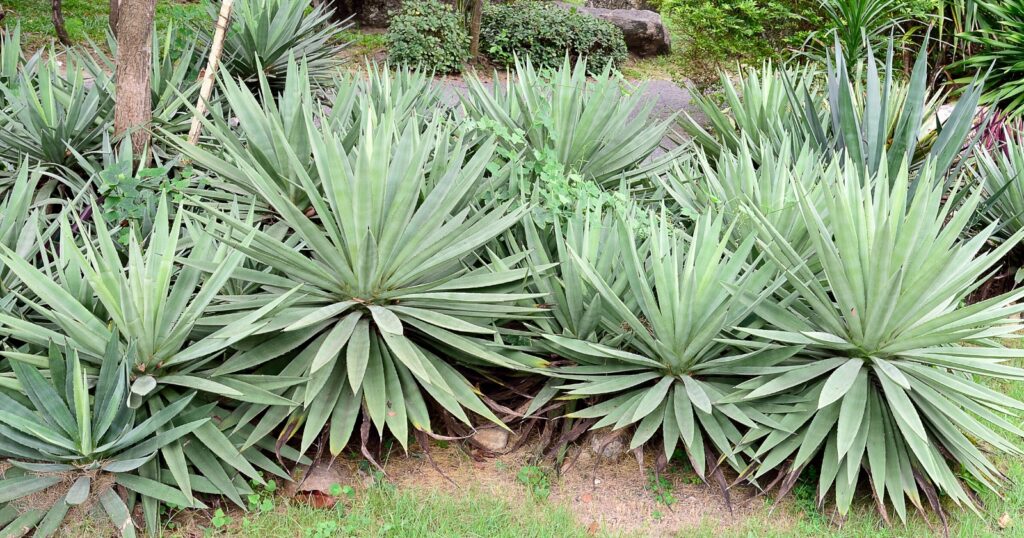
Scientific Name: Agave spp.
- Plant Type: Succulent
- Plant Size: 1-12 feet
- Watering Needs: Low
- Sun Exposure: Full sun
There are many varieties of Agave, and although they tend to get very large when grown outdoors, some can actually be grown as houseplants. During warm summer months, you can set your potted Agave outside to soak up the sun. In the winter, or when temperatures drop, bring it inside and place near a sunny window.
Agaves are well known for their large and showy flower spikes, but they are unlikely to bloom indoors, unless you have an indoor location that gets a great deal of sunlight, such as a bright greenhouse. A large-sized Agave will need a rather large pot with good drainage. The leaves are arranged as a basal rosette and can be quite sharp at the pointed ends, to be careful when moving around near your Agave.
Aloe Vera
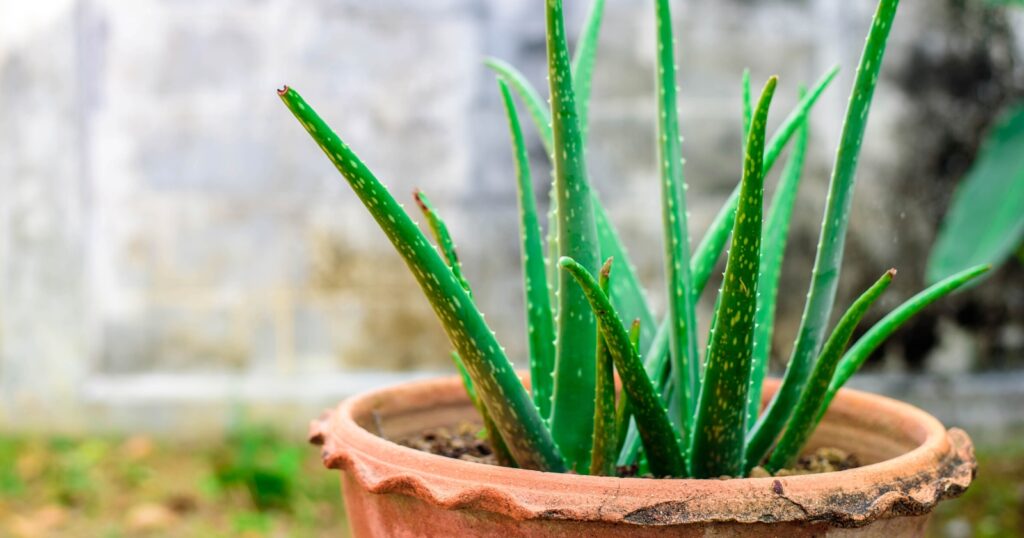
Scientific Name: Aloe vera
- Plant Type: Succulent
- Plant Size: 8”-12”
- Watering Needs: Low
- Sun Exposure: Part shade
Aloe Vera is a favorite house plant. The long thick, fleshy leaves grow up from around a central crown. Each leaf is green with little white speckles, and each leaf is edged with sharp “teeth.” If grown in ideal conditions, an Aloe can occasionally be coaxed into bloom with a long spike of small tubular flowers.
Aloe Vera grows well on a windowsill with bright but indirect sunlight. Water only when the soil is dry. Water deeply but then allow the soil to dry thoroughly between waterings. Eventually, Aloe “pups” will grow alongside the mother plant. These can be divided and transplanted when the pot becomes too full.
Baby Toes
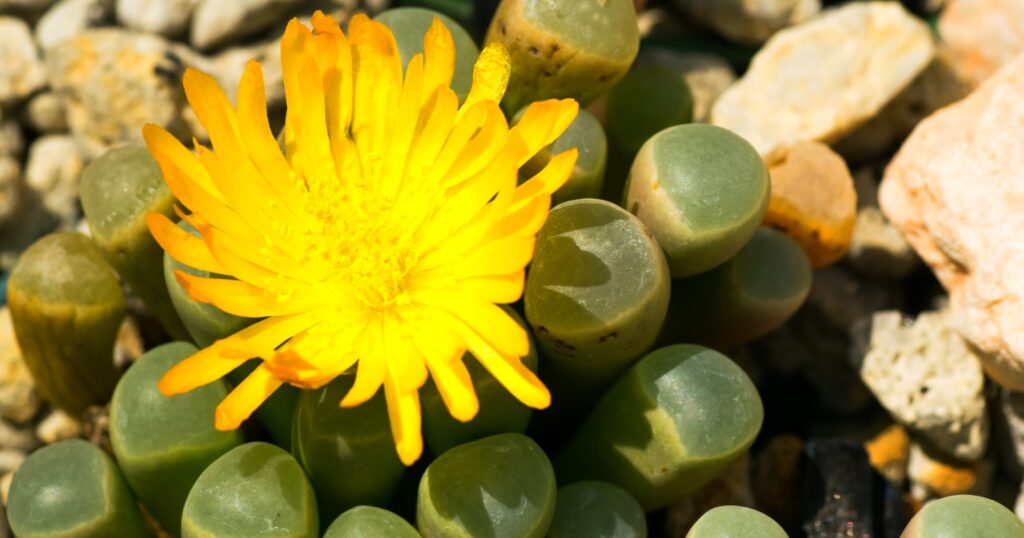
Scientific Name: Fenestraria rhopalophylla
- Plant Type: Succulent
- Plant Size: 2”-3”
- Watering Needs: Low
- Sun Exposure: Full sun
Baby Toes are tiny succulents that look like juicy little tubes emerging from the ground. They grow in dense clusters of rounded or flattened finger-like growths. They are pale green in color and smooth to the touch.
These diminutive plants look nice nestled between a few pebbles. Give them loose, well-drained soil and water sparingly. If you give them enough sunlight and are lucky enough to get them to flower, you will enjoy their cheery yellow blooms.
Beads Lampranthus
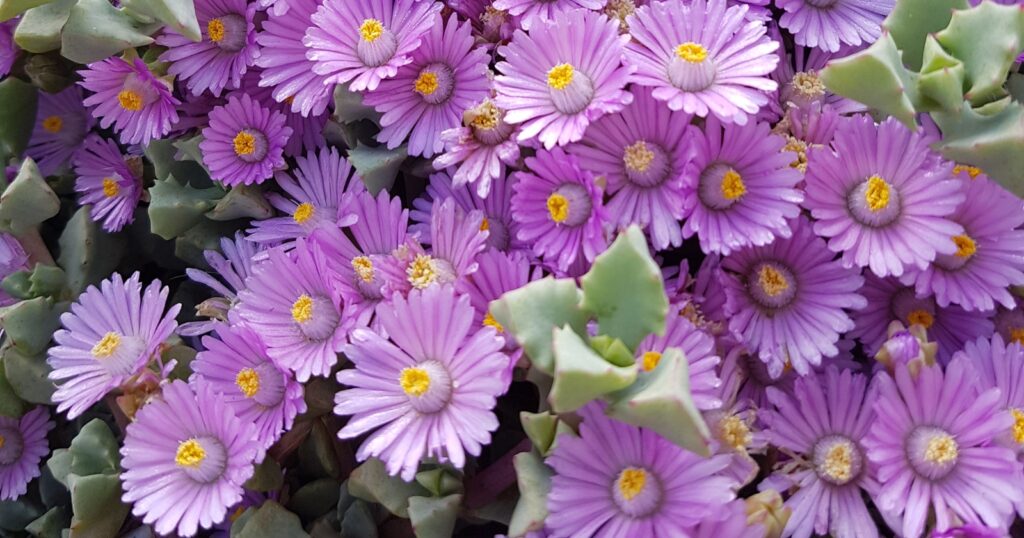
Scientific Name: Braunsia maximiliani
- Plant Type: Succulent
- Plant Size: 1-1.5 feet
- Watering Needs: Low
- Sun Exposure: Full sun
This gracefully draping succulent looks elegant hanging over the edge of a pot or hanging basket. Water it only when the soil has thoroughly dried. This plant does best with full sun, so a bright sunny window is ideal.
Beads Lampranthus grows long stems that make a good ground cover. Stems are interspersed with tiny clusters of small, thick leaves. In ideal conditions, the plant blooms with bright pink flowers along the stems, making it appear quite stunning.
Calico Kitten
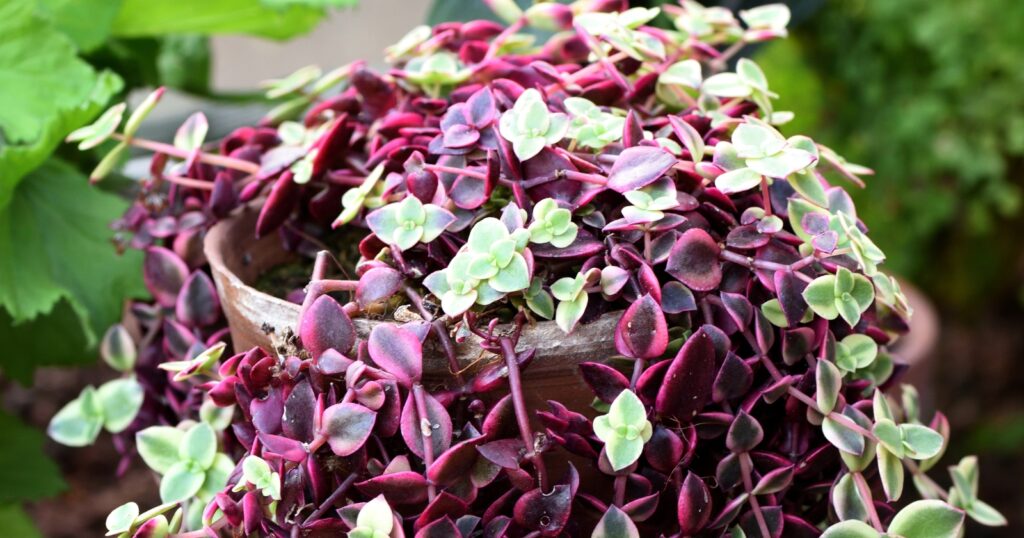
Scientific Name: Crassula pellucida ‘Variegata’
- Plant Type: Succulent
- Plant Size: 2-3 feet
- Watering Needs: Low
- Sun Exposure: Full sun
Calico Kitten is unusual because it doesn’t look like a typical succulent. This trailing, vining plant has slightly thickened bright pink, white, and green leaves. The long leaf-covered stems drape over the edge of a pot or hanging basket.
Give this plant a window with plenty of bright sunlight to help it stay colorful and compact. If the stems are growing long and leggy, this is a sign your plant probably needs more light. Stems are rather fragile, and if a section of stem breaks off, it can be rooted in a new pot with loose, well-drained succulent soil.
Chinese Jade
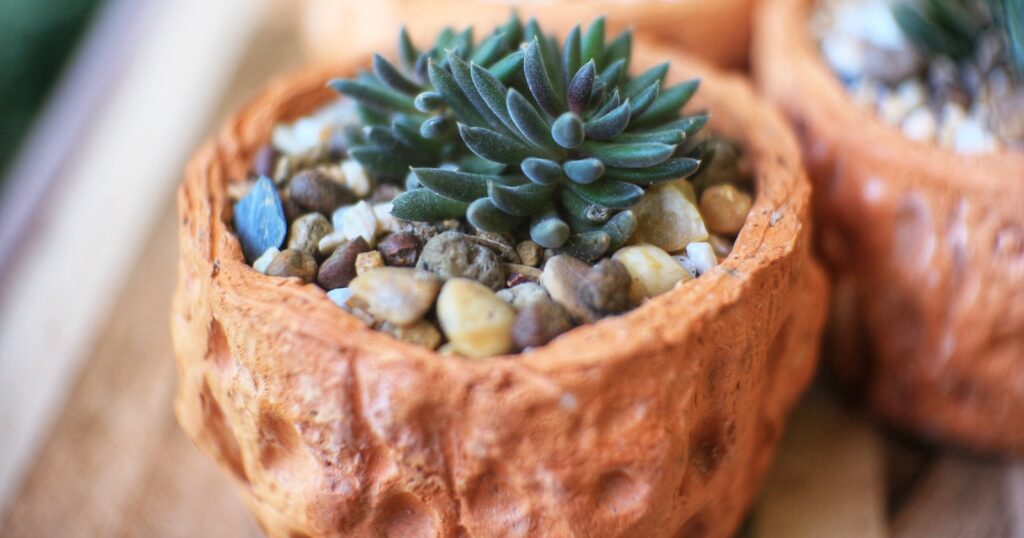
Scientific Name: Sinocrassula yunnanensis
- Plant Type: Succulent
- Plant Size: 3”-4”
- Watering Needs: Low
- Sun Exposure: Full sun
The Chinese Jade is a low-growing compact succulent. Tiny thickly-pointed leaves densely cover the short stems. During flowering, small white flower clusters appear on long stalks which emerge from the ends of the leafy stems.
Over time, Chinese Jade will spread in its pot and create a thick ground cover of chunky pointed leaves. These plants don’t need to be watered until the soil is completely dry. They will do best and have the greatest chance of flowering in a location with plenty of bright sunlight.
Christmas Cactus
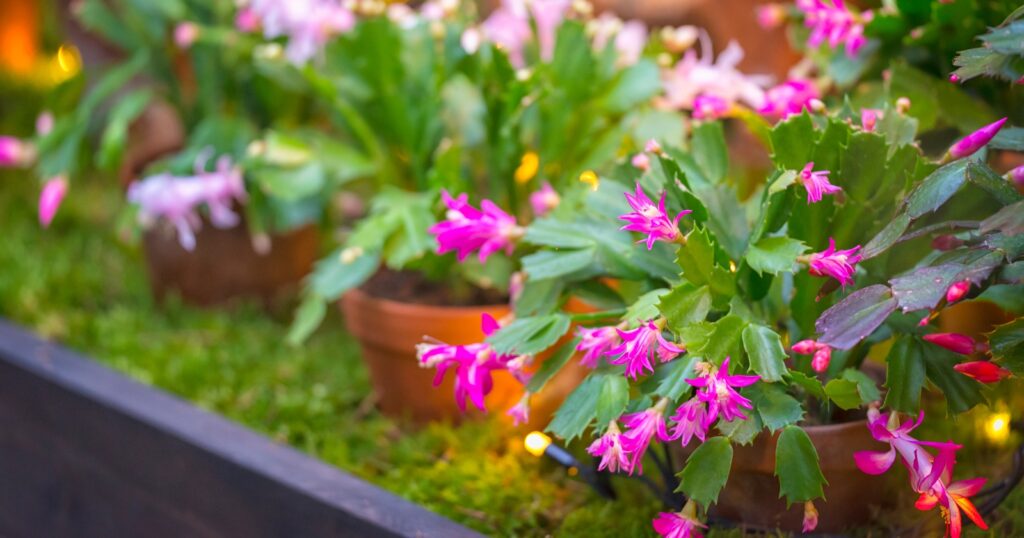
Scientific Name: Schlumbergera spp.
- Plant Type: Succulent
- Plant Size: 1-1.5 feet
- Watering Needs: Low
- Sun Exposure: Partial sun
Christmas Cactus is one of the most readily available succulents. They bloom annually, typically in late fall through early winter. Dramatic, showy blooms grace the ends of many-sectioned leaves. Flower colors come in many shades of pink.
Water your Christmas Cactus only when the soil is thoroughly dry; once every 2-3 weeks is usually plenty. Soil should be well drained and loose. Potting soil formulated for cacti and succulents works well for these plants. Christmas Cactus can burn if they receive too much direct sunlight, so give them a place with bright, but indirect sun.
Cobweb Houseleek
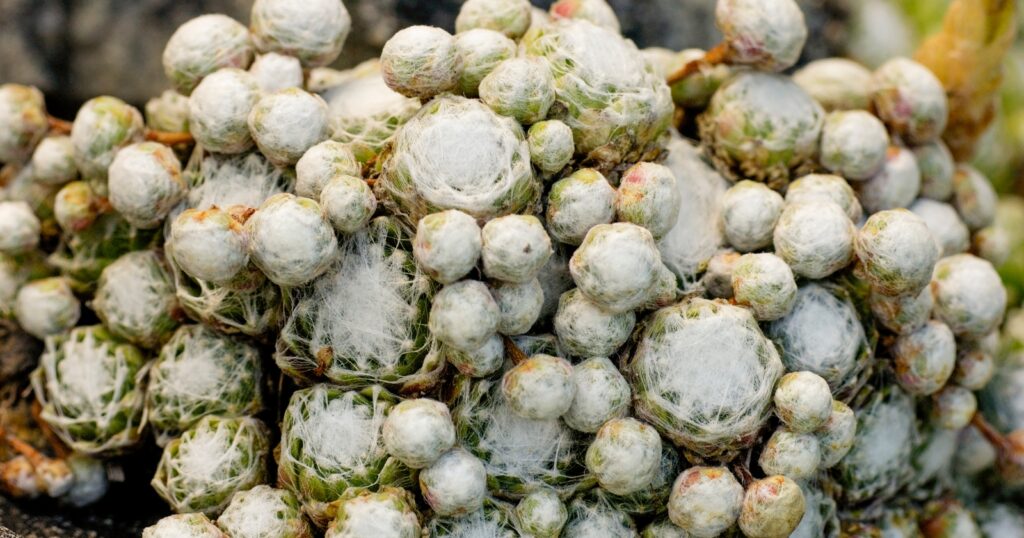
Scientific Name: Sempervivum arachnoideum
- Plant Type: Perennial succulent
- Plant Size: 3”-4”
- Watering Needs: Low to medium
- Sun Exposure: Full sun
This interesting looking succulent forms a light green leafy rosette with white, spiderweb-like silky strands connecting each of the leaf tips. It’s appearance may be quite unique and exotic, but it is fairly easy to grow. These plants are cold hardy from zones 5-8, but may not appreciate extremely hot and humid summer days.
Cobweb Houseleek prefers a site with full sun. Water it whenever the soil dries completely. If growing in a container, be sure the container has good drainage holes. Soil should be well-drained and sandy.
Cocoon Plant
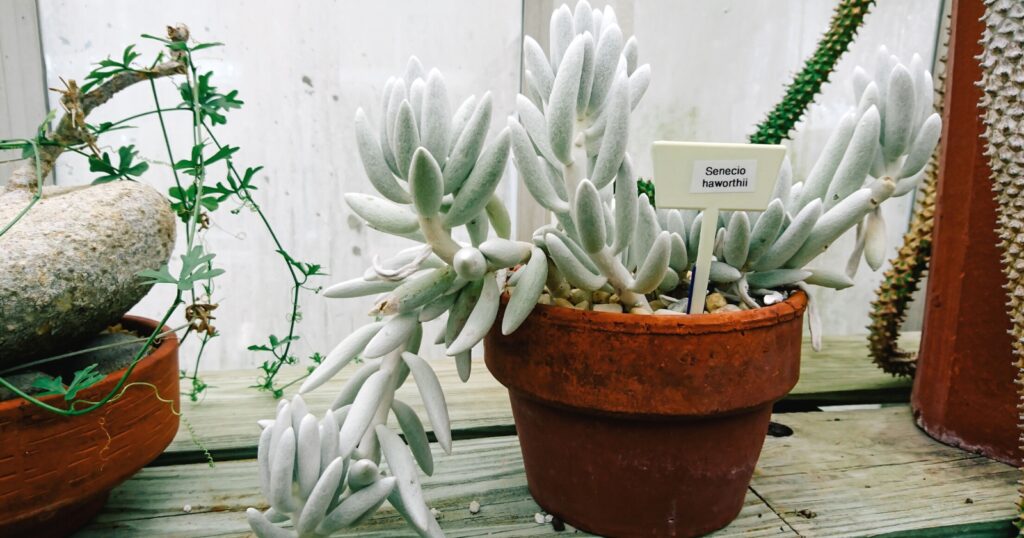
Scientific Name: Senecio haworthii
- Plant Type: Succulent
- Plant Size: 9”-12”
- Watering Needs: Low
- Sun Exposure: Full sun
Cocoon Plant has leaves that look like fuzzy white cocoons. The thick oblong leaves are slightly fuzzy and grow along thick silvery-white stems. This plant has an upright growth habit and the white color is both attractive and unusual.
Grow Cocoon Plant in a sunny window. Allow the soil to dry thoroughly between waterings. The leaves of this plant are easily broken off from the stem, so take care when handling it. The good news is that any broken leaves can be easily rooted, as can broken sections of stem.
Coral Crassula
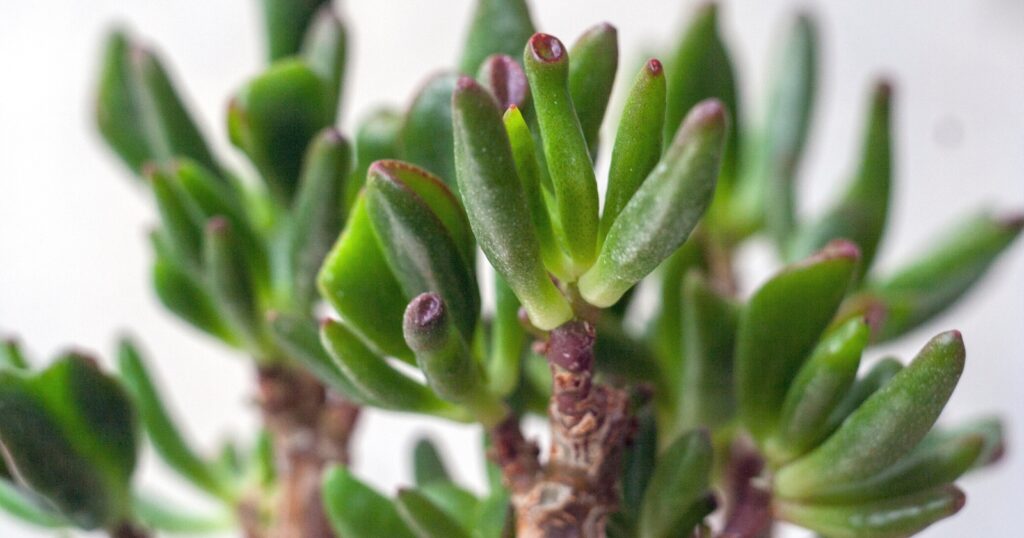
Scientific Name: Crassula corallina
- Plant Type: Succulent
- Plant Size: 3”-8”
- Watering Needs: Low
- Sun Exposure: Full sun to part shade
This little plant is fun to look at. Thick stubby leaves are densely packed onto short upright stems. Leaves are speckled white and green, which gives them a slightly rough appearance, although they are actually smooth to the touch. If given ideal conditions, tiny yellow blooms will appear and the ends of the leafy stalks.
Coral Crassula does best in a bright sunny window. Like many other leafy succulents, bits of stem can be broken off and used to propagate a new plant. Soil should be loose and very well-drained. Allow the soil to dry completely between waterings.
Crown of Thorns
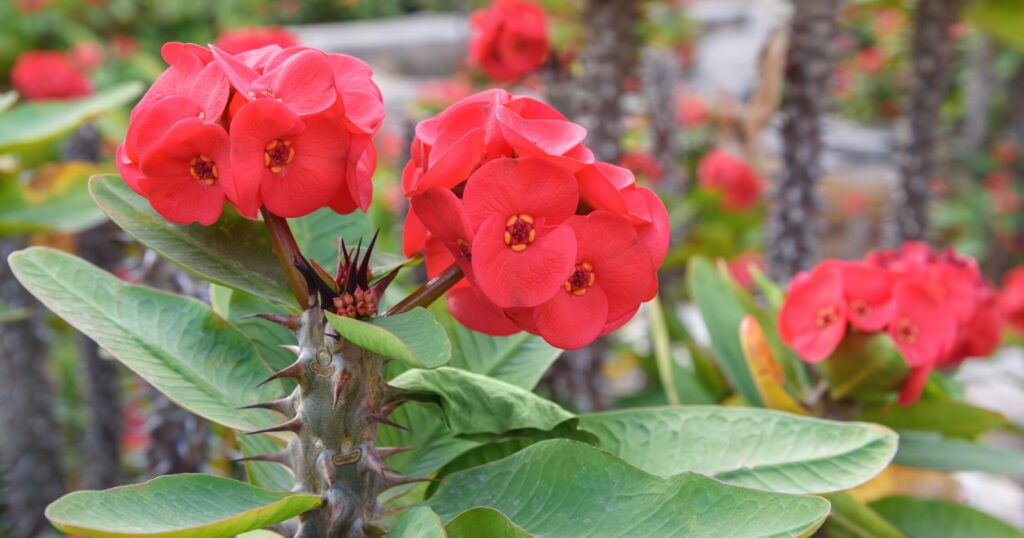
Scientific Name: Euphorbia milii
- Plant Type: Succulent
- Plant Size: 1-2 feet
- Watering Needs: Low to moderate
- Sun Exposure: Full sun to part shade
Crown of Thorns may not look like a typical succulent. It has a thick, woody, succulent trunk generously protected with rather dramatic spines. Despite the dangers offered by its sharp spines, the Crown of Thorns is grown for its showy red flowers. This plant will readily bloom when grown indoors in a sunny window location. Crown of Thorns is relatively slow growing, but as it grows taller and heavier, be sure to repot it as necessary, and be sure to wear some sturdy gloves.
Cushion Aloe
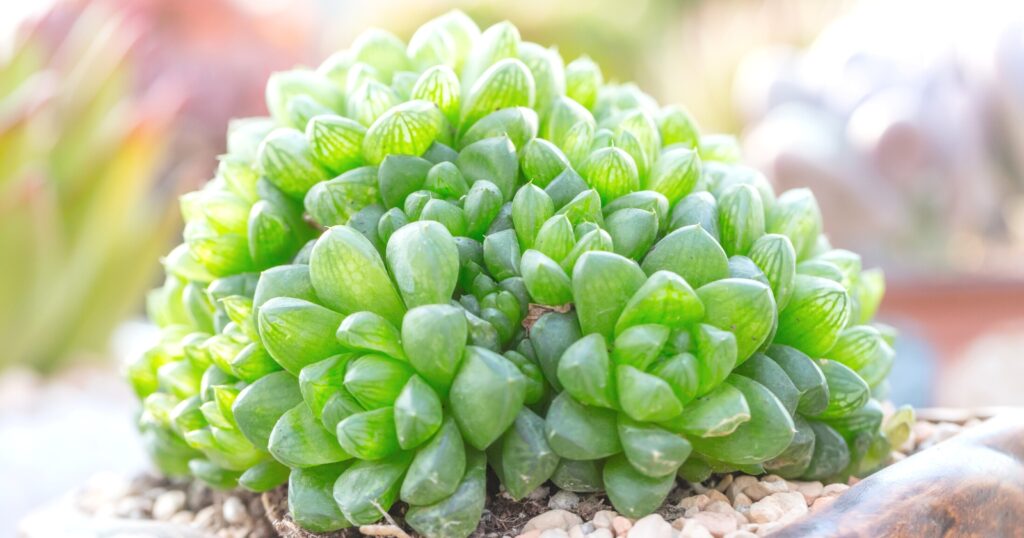
Scientific Name: Haworthia cooperi
- Plant Type: Succulent
- Plant Size: 2”
- Watering Needs: Low
- Sun Exposure: Part shade
Cushion Aloe is a cute little plant that grows just a couple of inches tall. The leaves are very thick and juicy looking, growing in a tight rosette. The leaves are generally light green and have a tendency to appear translucent, giving them the appearance of being very delicate. They are actually rather easy to grow and make an excellent addition to a succulent collection.
Give these plants a window with bright light, but they don’t need direct sunlight. Give them a well-drained succulent potting soil in a pot with good drainage holes. Water them only when their soil is thoroughly dry.
Donkey’s Tail
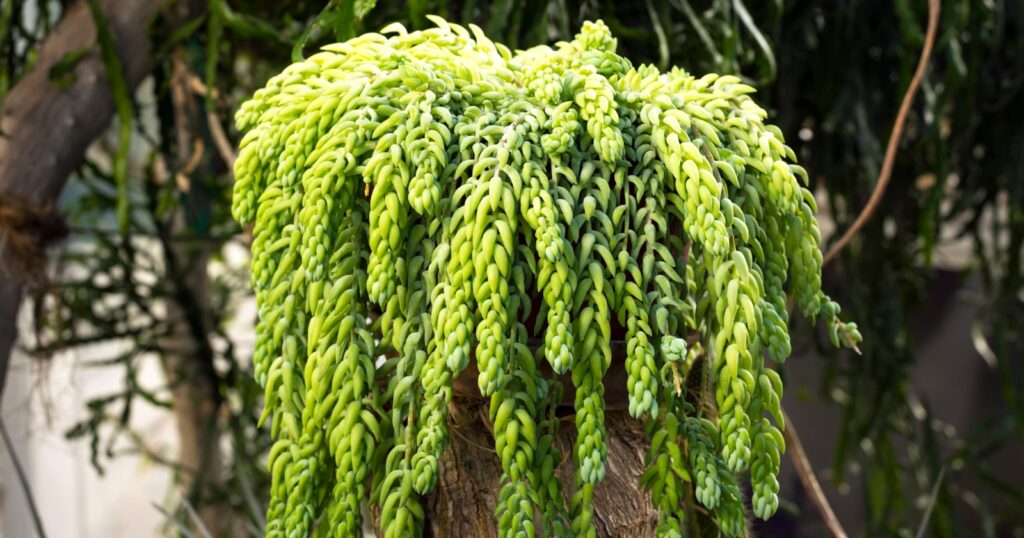
Scientific Name: Sedum morganianum
- Plant Type: Succulent
- Plant Size: 1-2 feet
- Watering Needs: Low
- Sun Exposure: Full sun to part shade
Donkey’s Tail, or Burro’s Tail, is a fairly common succulent. This low-growing plant looks like a dense string of tiny fat leaves covering a trailing or draping stem. These plants have the potential to grow quite long, but the stems are quite fragile and the hanging leaves and stems break easily.
Choose a sunny window for the Donkey’s Tail. Give it enough space to sprawl a little. It won’t grow particularly tall, but it will drape itself over the edge of the pot. Donkey’s Tail needs to be watered only when the soil has thoroughly dried. It can withstand a fair amount of drought, so don’t worry about forgetting about it for a while.
Dudleya
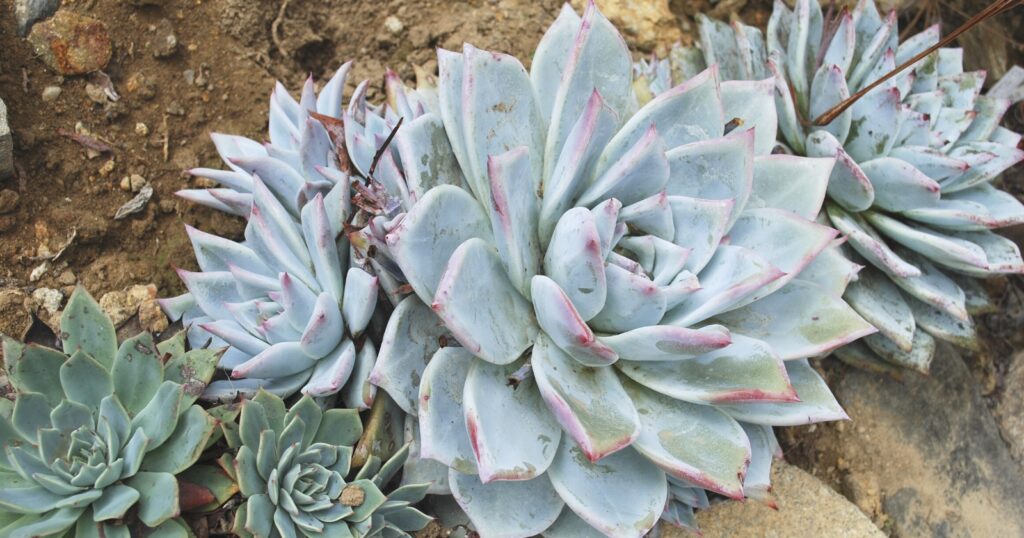
Scientific Name: Dudleya spp.
- Plant Type: Succulent
- Plant Size: 6”-2 feet
- Watering Needs: Low
- Sun Exposure: Full sun
There are many species of Dudleya, and while some may be better suited to an outdoor rock garden in a mild climate, others may be available as houseplants. These plants are rugged survivors and are well adapted to harsh environmental conditions, such as full sunlight, poor quality soil, and little water.
As houseplants, grow them in a sunny window with as much light as you can provide. Use loose, well-drained soil and water only when the soil has dried completely. Some varieties of Dudleya are endangered species and protected by law. Be sure to purchase your plants from a reputable grower where they have been legally cultivated.
Elephant Bush
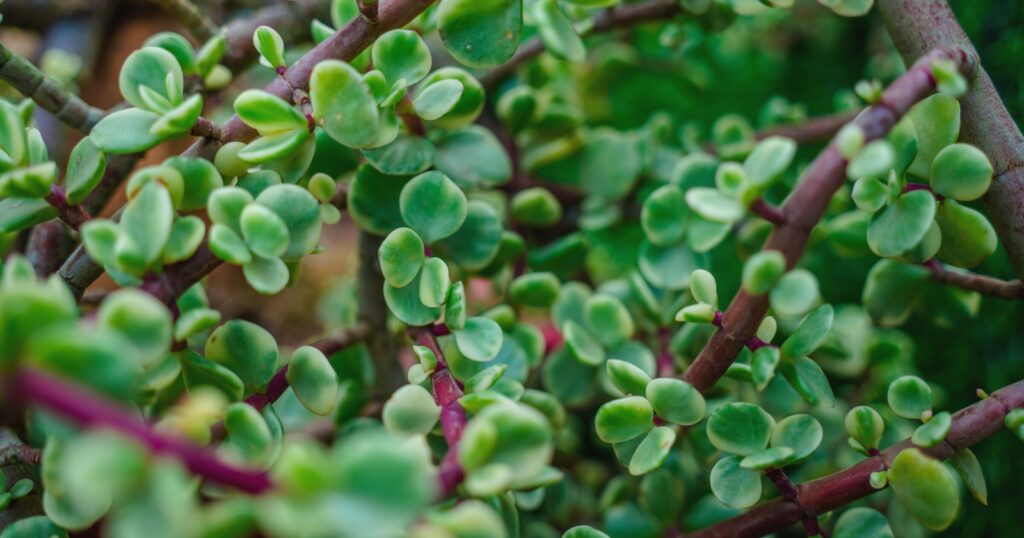
Scientific Name: Portulacaria afra
- Plant Type: Succulent shrub
- Plant Size: 1-2 feet
- Watering Needs: Low
- Sun Exposure: Full sun
With a name like Elephant Bush, one would expect this plant to grow quite large. In its natural environment, Elephant Bush can reach a stately size of 6-20 feet tall, but grown indoors as a houseplant, it will typically remain less than 2 feet tall. A mature plant has a very shrub-like growth form.
Grow these thick-stemmed plants in a sturdy pot with good drainage. Soil should be loose and well-drained. Allow them to dry completely between waterings and be sure to give them plenty of light. These plants would do well grown outdoors in the summer, and then moved inside for the winter.
Fairies Washboard
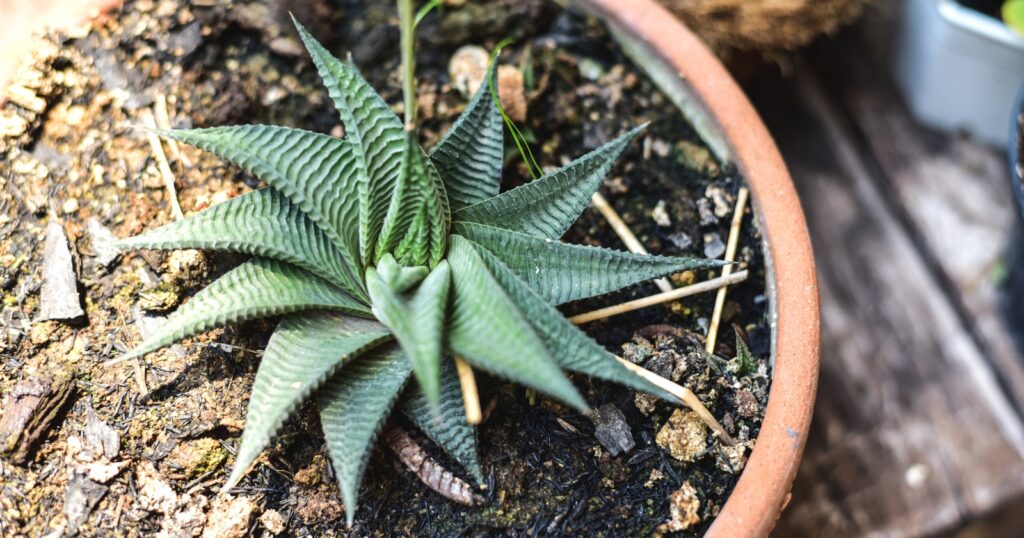
Scientific Name: Haworthia limifolia
- Plant Type: Succulent
- Plant Size: 4”
- Watering Needs: Low
- Sun Exposure: Partial shade
This compact succulent has attractive ridged leaves. Leaves are bright green and stoutly triangular, coming to a sharp point. They are slow growing and stay fairly low to the ground. Fairies Washboard are easily grown in a pot of well-drained soil formulated for succulents. This succulent does well in a window with plenty of indirect sunlight, but will tolerate shadier conditions than many other succulents.
Flaming Katy
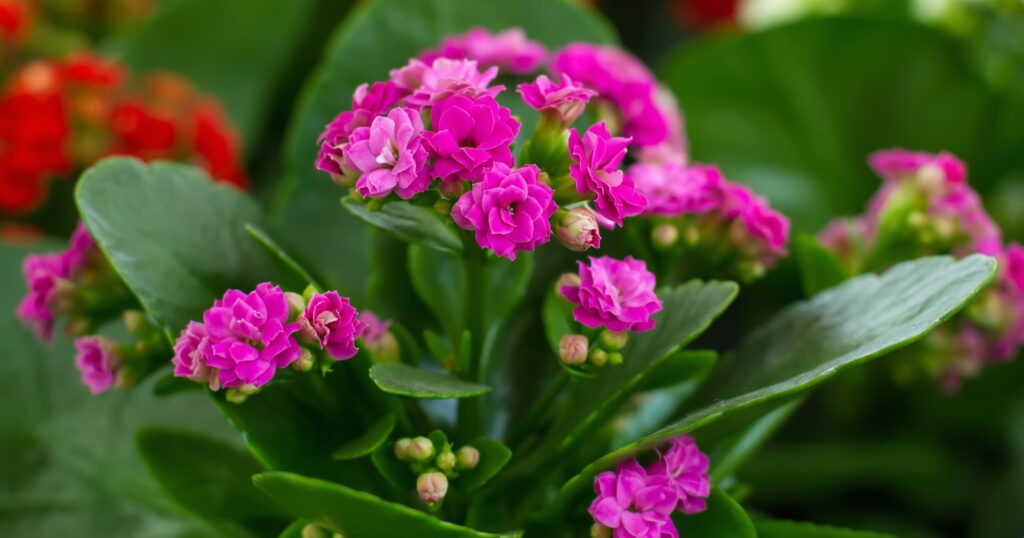
Scientific Name: Kalanchoe blossfeldiana
- Plant Type: Succulent
- Plant Size: 10”-16”
- Watering Needs: Low to moderate
- Sun Exposure: Full sun
The Flaming Katy is named for its bright, flame-colored flowers in shades of red, pink and orange. Broad, leathery leaves grow along a sturdy upright stem. Leaves are typically a rich, dark green color, but can turn reddish-tinged in bright sunlight. Given enough sunlight, these plants bloom readily.
Grow them in well-drained succulent soil and be sure the pot is sturdy enough to handle some growth and spread. Flaming Katy can become robust and can easily become top heavy in a pot that’s too small and light. There are smaller miniature varieties available as well that are ideal for a smaller space.
Ghost Plant
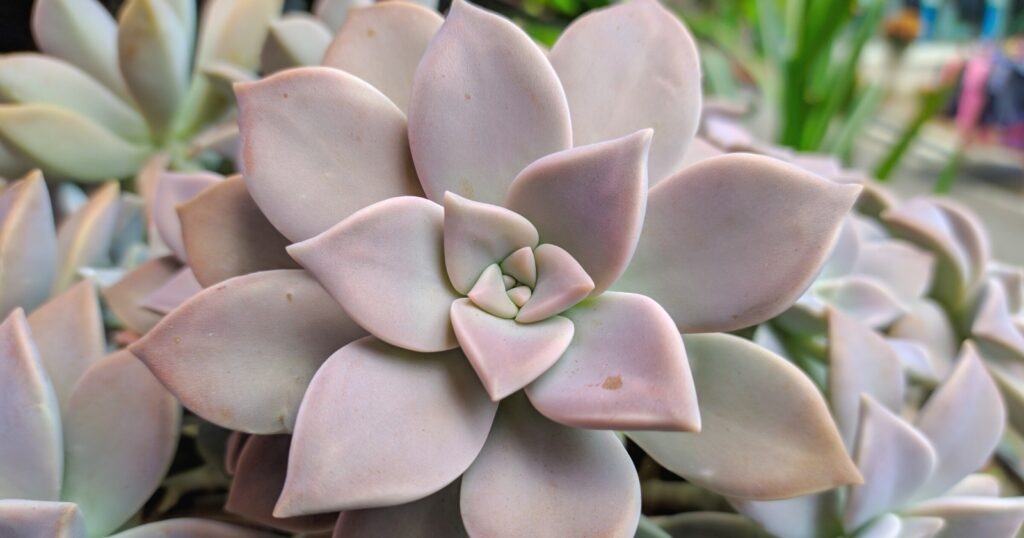
Scientific Name: Graptopetalum paraguayense
- Plant Type: Succulent
- Plant Size: 1-3 feet
- Watering Needs: Low
- Sun Exposure: Full sun to part shade
The Ghost Plant will not haunt you with challenging care requirements. It is an easy to grow, low-maintenance houseplant. Give it a sunny window, well-drained soil, and occasional water and it should grow well in a home environment.
The pale silvery leaves of the Ghose Plant give it its name and unique appearance. Plants begin as a compact leafy rosette, but eventually grow long stems ending in a leafy rosette. Leaves whither along the stem as the stem grows, leaving a long trailing leafless stem which can be allowed to drape over the edge of a pot or along a sunny windowsill.
Hedgehog Aloe
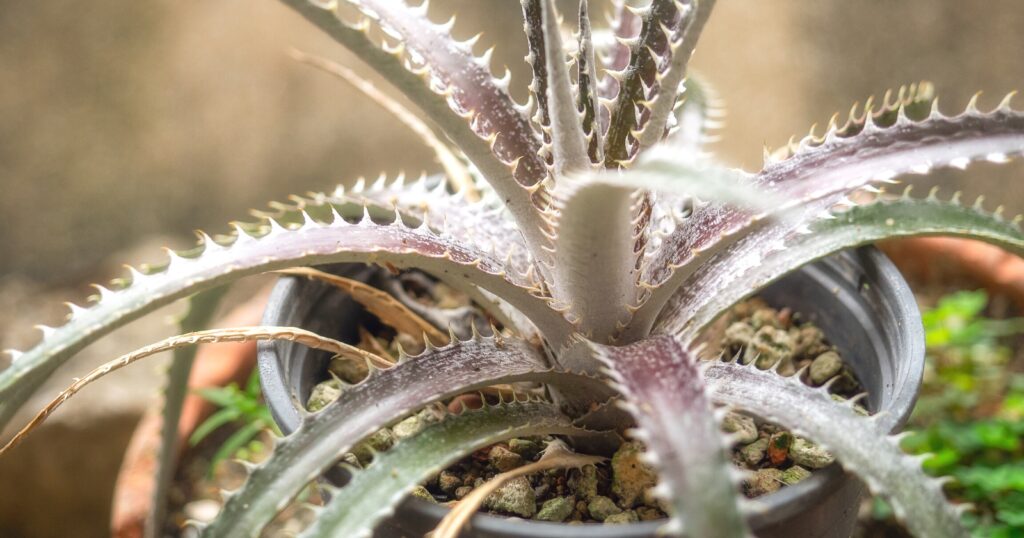
Scientific Name: Aloe humilis
- Plant Type: Succulent
- Plant Size: 6”
- Watering Needs: Low
- Sun Exposure: Full sun
Hedgehog Aloe, also called Spider Aloe, is a relatively small plant that is well suited to growing in a pot. Leaves are thick and oblong, covered with stout white points. Plants grow as dense, upright, leafy rosettes.
Grow Hedgehog Aloe in a bright, sunny window. Plant it in well-drained cactus soil and make sure your pot has good drainage holes. Over time, your plant will grow pups. When the pot gets too crowded, you can divide some or all of the pups from the parent plant and repot them in separate pots with fresh soil.
Hens and Chicks
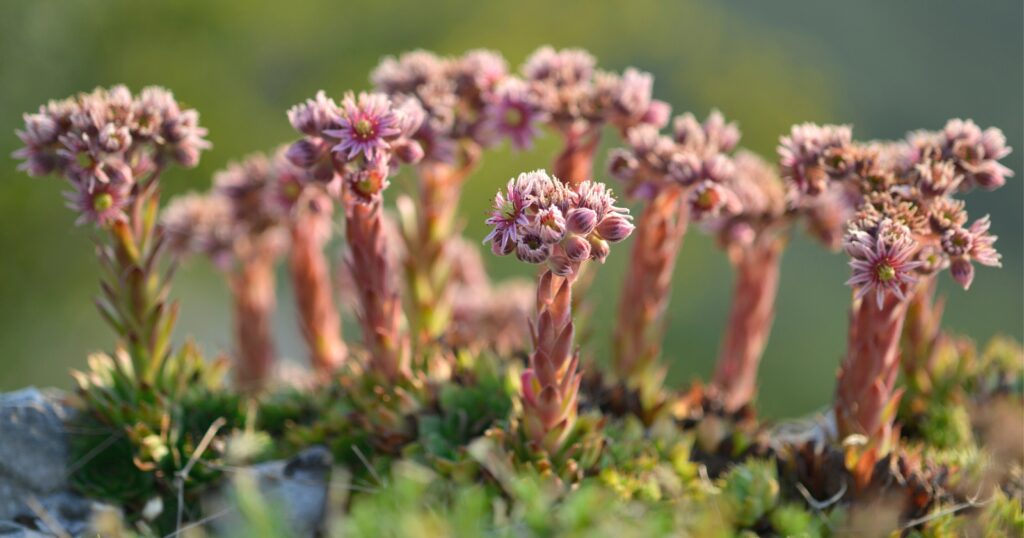
Scientific Name: Sempervivum tectorum
- Plant Type: Perennial succulent
- Plant Size: 3”-6”
- Watering Needs: Low to medium
- Sun Exposure: Full sun
This variety of Hens and Chicks, also known as the Common Houseleek, is hardy from zones 3-8 and makes an excellent addition to a rock garden or drought-tolerant edge. It can also be grown as a potted plant. In a decent-sized pot with good drainage, you can easily grow these outside in the summer, and bring them in for the winter as a showy and unusual houseplant.
Hens and Chicks are a low growing perennial ground cover. They spread slowly, creeping outwards from the primary rosette and forming many new, smaller rosettes. Plants can be divided, if necessary, or simply allowed to grow naturally.
Ice Plant
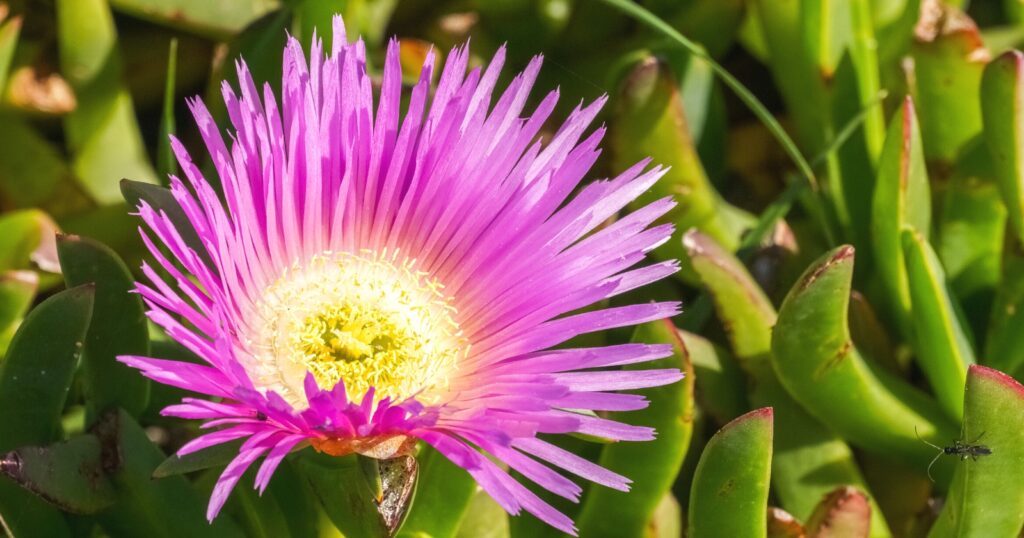
Scientific Name: Oscularia deltoides
- Plant Type: Succulent
- Plant Size: 6”-12”
- Watering Needs: Low
- Sun Exposure: Full sun
Ice Plant is a thick-leaved ground cover. It can be grown outdoors in a rock garden in zones 8-11. It can also easily be grown indoors as a houseplant. Leaves are thick and triangular, growing densely along thick succulent stems. This plant will sprawl and grow close to the ground, with larger stems trailing over the edges of the pot or along the ground.
Give this plant as much light as you can. It can be grown outdoors in the summer and moved indoors for the colder winter months. Ice plant is fairly hardy and doesn’t require much water. Use well-drained succulent soil and allow the soil to dry thoroughly between watering. In ideal conditions, this plant is a reliable bloomer with an abundance of bright pink, daisy-like flowers.
Jade Plant
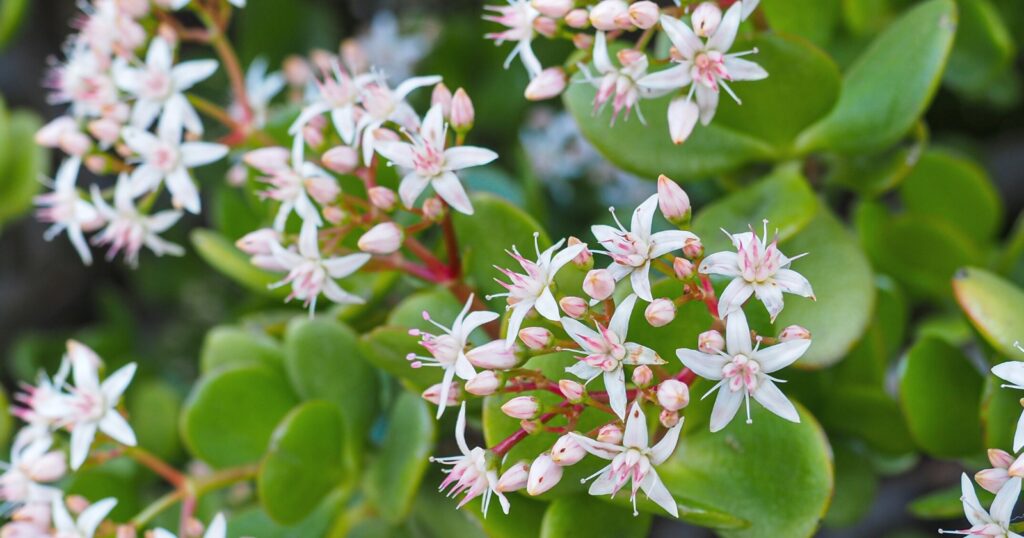
Scientific Name: Crassula argentea
- Plant Type: Succulent
- Plant Size: 1-4 feet
- Watering Needs:Low
- Sun Exposure: Full sun to part shade
Jade Plant is a popular and low-maintenance house plant. They have thick sturdy stems lined with fleshy green leaves. Plants will grow by producing longer and longer stems and branches until branches start to droop into graceful curves.
Any leaf that falls from a Jade Plant has the potential to develop into a tiny new plant. To propagate Jades, simply break off a healthy leaf and lay the short stem on the surface of the soil. Within a few weeks, new roots will develop, and shortly thereafter, a new tiny set of leaves will emerge.
Jade ‘Hummel’s Sunset’
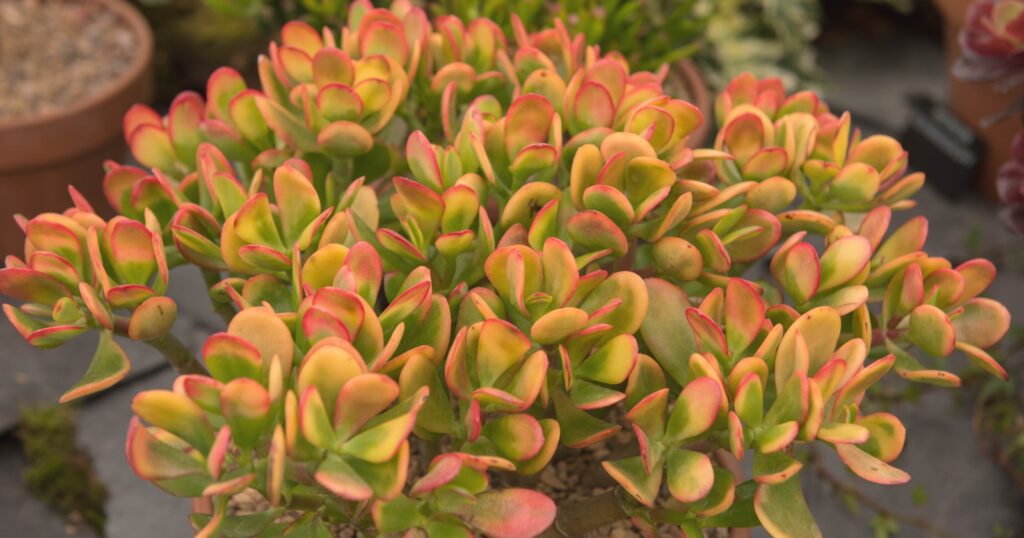
Scientific Name: Crassula ovata ‘Hummel’s Sunset’
- Plant Type: Succulent
- Plant Size: 1-3 feet
- Watering Needs: Low
- Sun Exposure: Full sun to part shade
The Jade Plant ‘Hummel’s Sunset’ or ‘Golden Jade’ is a beautiful and slightly more exotic variety of Jade Plant. Leaves are fleshy and green, and tinged around the edges with bright pink. In ideal conditions, this Jade will flower, and while the flowers aren’t particularly showy, you will know your Jade is happy enough to bloom.
Grow Jade Plants where they get plenty of bright sunlight, but they don’t need full sun. They prefer soil that is loose and well-drained and only need watering when the soil has dried completely. Be sure to give them a large enough pot, as the thick stems and heavy leaves can cause them to be rather top-heavy.
Jelly Bean Plant
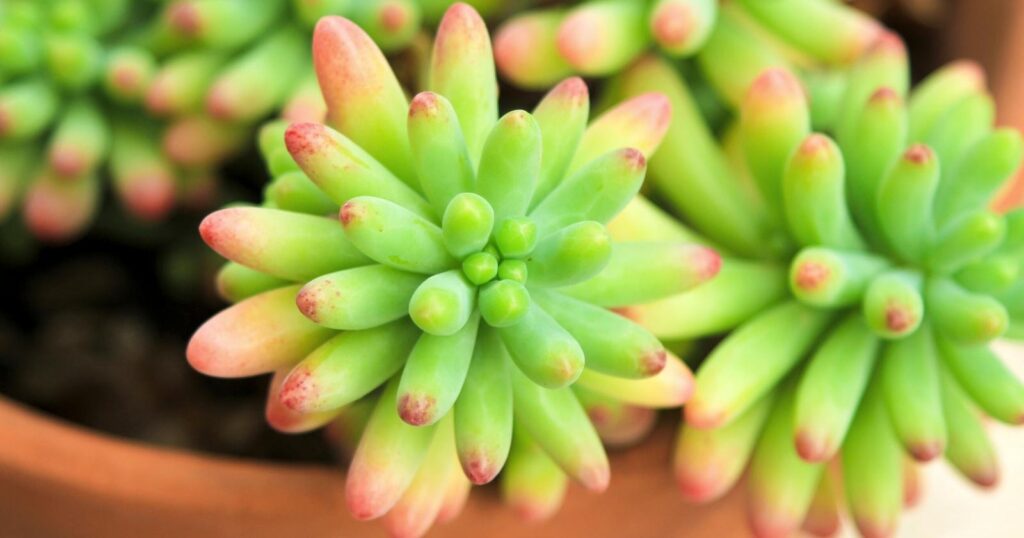
Scientific Name: Sedum rubrotinctum
- Plant Type: Succulent
- Plant Size: 6”-12”
- Watering Needs: Low
- Sun Exposure: Full sun
The Jelly Bean Plant is a sweet, compact succulent that makes an excellent ground cover. When grown indoors in a pot, be sure to give it plenty of bright sunlight and loose, well-drained soil. These plants don’t need much water; only water after the soil has thoroughly dried.
Jelly Bean Plants have small, oblong, bean-like leaves which are bright green with reddish tips. Leaves grow densely up the stems. Smaller plants will grow upright, but eventually become top heavy and will begin to sprawl or drape over the edge of the pot.
Lucky Heart Plant
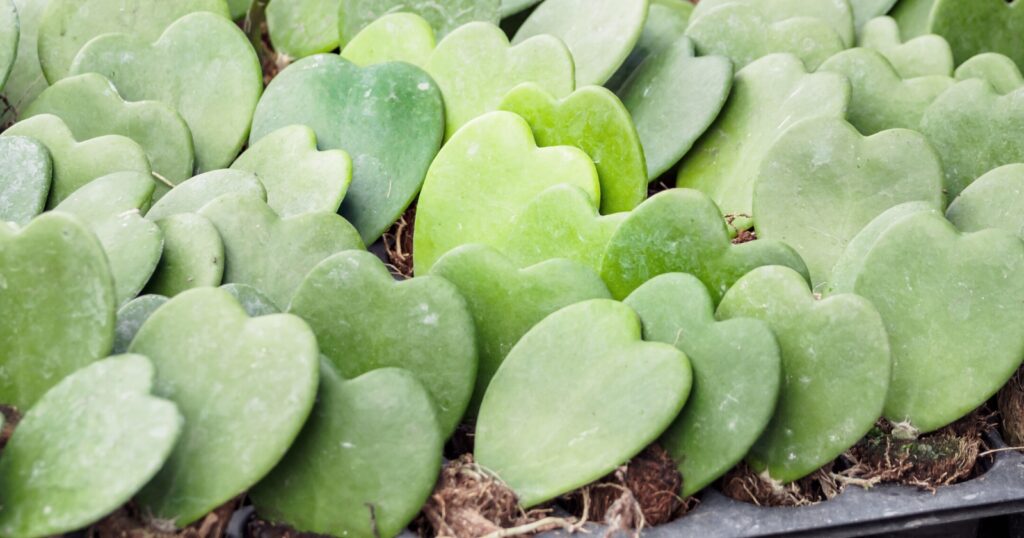
Scientific Name: Hoya kerrii
- Plant Type: Succulent
- Plant Size: Up to 12 feet
- Watering Needs: Low
- Sun Exposure: Full sun
The Lucky Heart Plant is typically sold as a single leaf rooted in a pot, giving the appearance of a heart growing in the soil. That single leaf, however, is simply a single leaf with root development, and will rarely grow into an entire plant. Lucky heart plants can be propagated by taking a cutting that includes a leaf and stem node. When fully rooted, the stem will sprout a new stem from the base.
If allowed to grow to its full capacity, the stem of a healthy Lucky Heart Plant can grow to approximately 12 feet long and have a very thick waxy heart-shaped leaf every few inches. These long vines can be trained to grow along an upright support, or allowed to trail down from a hanging pot or along a sunny windowsill.
Moonstone Plant
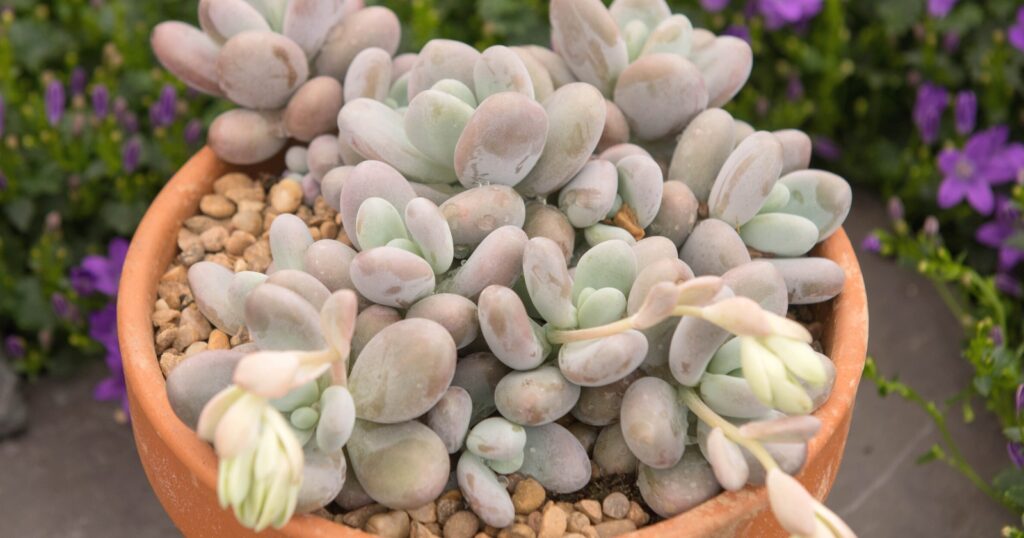
Scientific Name: Pachyphytum oviferum
- Plant Type: Succulent
- Plant Size: 6”-12”
- Watering Needs: Low
- Sun Exposure: Full sun to part shade
A pot filled with Moonstone Plant looks like a pot of smooth, pearly pebbles. Leaves are very pale greenish-blue and perfectly smooth and oval shaped. Some leaves may develop a pinkish or purplish hue. Thick chunky stems grow upright from the pot. Plants drop leaves easily and a fresh leaf can be rooted to grow a new plant.
Grow your Moonstone Plant in a sturdy pot because taller plants may become top heavy. Give them a bright, sunny window and water them only when the soil has thoroughly dried. These plants are prone to root rot so make sure the pot has good drainage and plants are never allowed to sit in wet soil.
Mother of Thousands
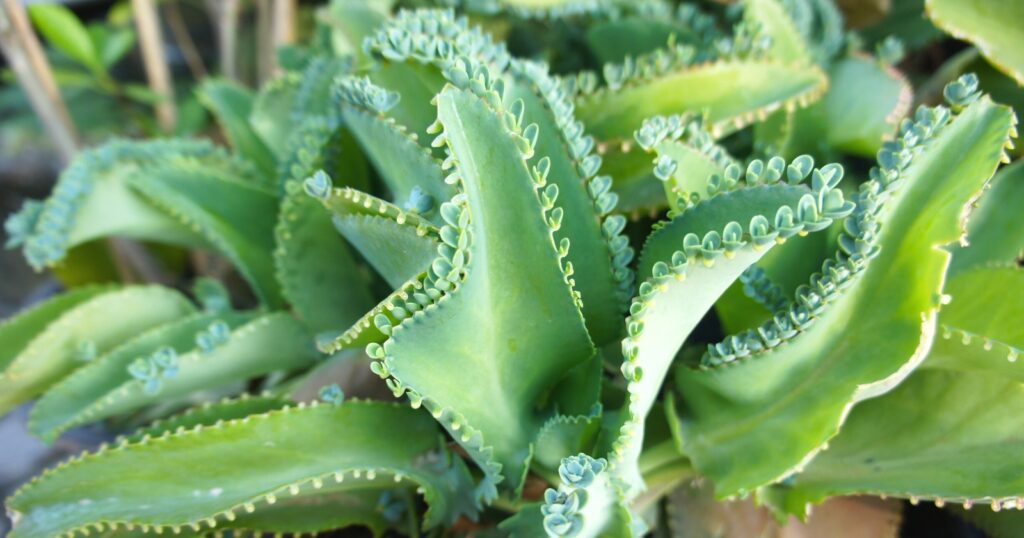
Scientific Name: Kalanchoe daigremontiana
- Plant Type: Succulent
- Plant Size: 1-2 feet
- Watering Needs: Low to moderate
- Sun Exposure: Full sun
This interesting houseplant can generate literally thousands of offspring directly along the edges of its leaves. Tiny baby plants develop both leaves and roots while attached to the mother plant, then drop off onto the soil below, take root, and can form massive colonies if allowed to grow freely. As a houseplant, this is rarely a problem because your plant will be contained within a single pot and unwanted offspring can be easily removed.
Ox Tongue
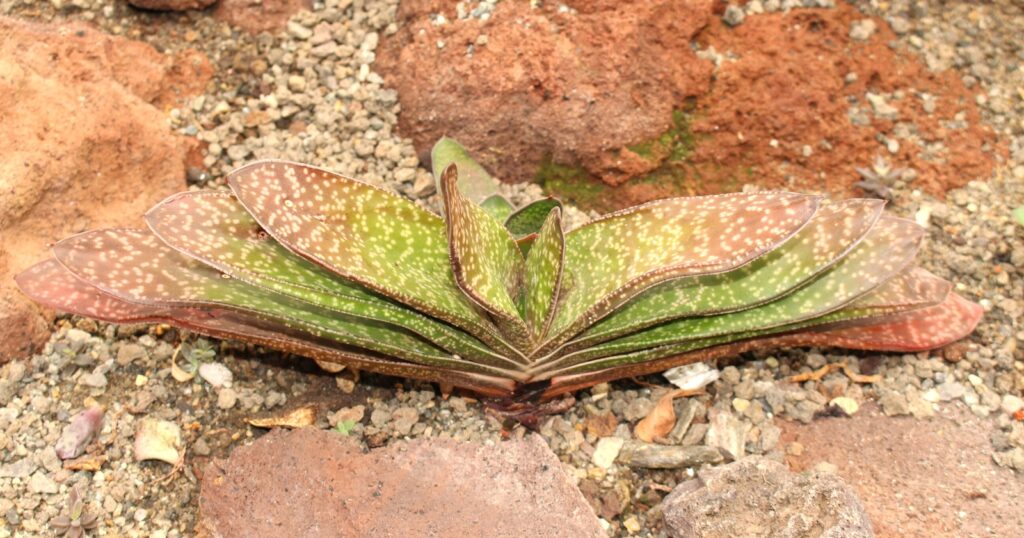
Scientific Name: Gasteria spp.
- Plant Type: Succulent
- Plant Size: 6”-2 feet
- Watering Needs: Low
- Sun Exposure: Full sun to part shade
These plants have thick rough leaves edged by a row of tiny, sharp teeth. Leaves are deep green with pale green speckles that give them a distinct texture. Leaves grow in a dense rosette and stay fairly compact.
Ox Tongue do best in a sunny window, but not fully direct sun. They need a sandy, well-drained soil and should be watered only when the soil has dried completely. These plants are slow growing, low maintenance, and quite interesting to look at.
Panda Plant
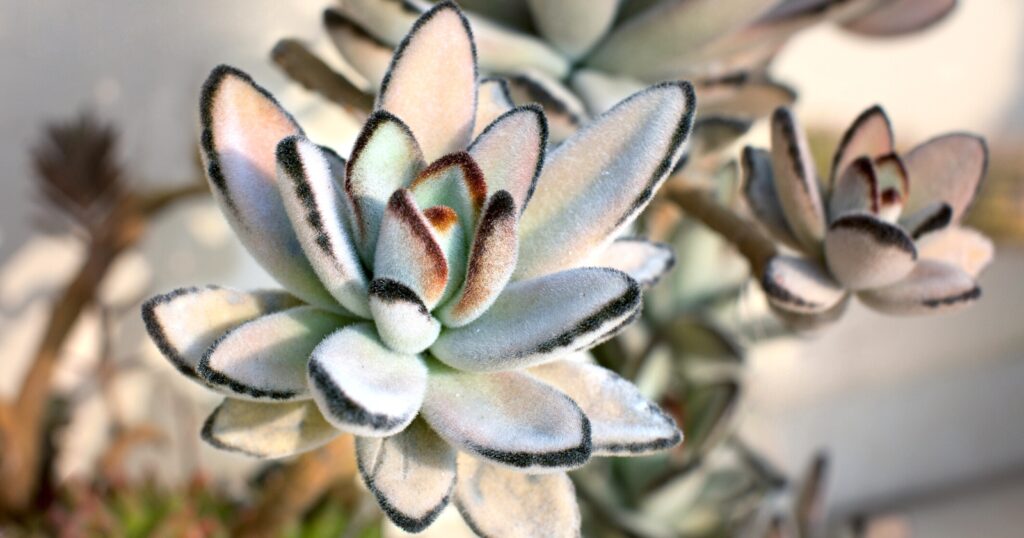
Scientific Name: Kalanchoe tomentosa
- Plant Type: Succulent
- Plant Size: 1-1.5 feet
- Watering Needs: Low to moderate
- Sun Exposure: Full sun to part shade
The Panda Plant is a popular houseplant for good reason. It is both beautiful and easy to care for. Leaves are light green but thoroughly covered with a soft white fuzz and edged with cinnamon brown. The thick stems grow upright with a leaves arranged all along. Plants can easily be propagated by leaf and stem cuttings.
These plants grow well in a basic, well-drained succulent soil. Be sure the pot has good drainage and water only when the soil has dried completely. They prefer a fully sunny window but will also tolerate partial shade.
Pencil Tree
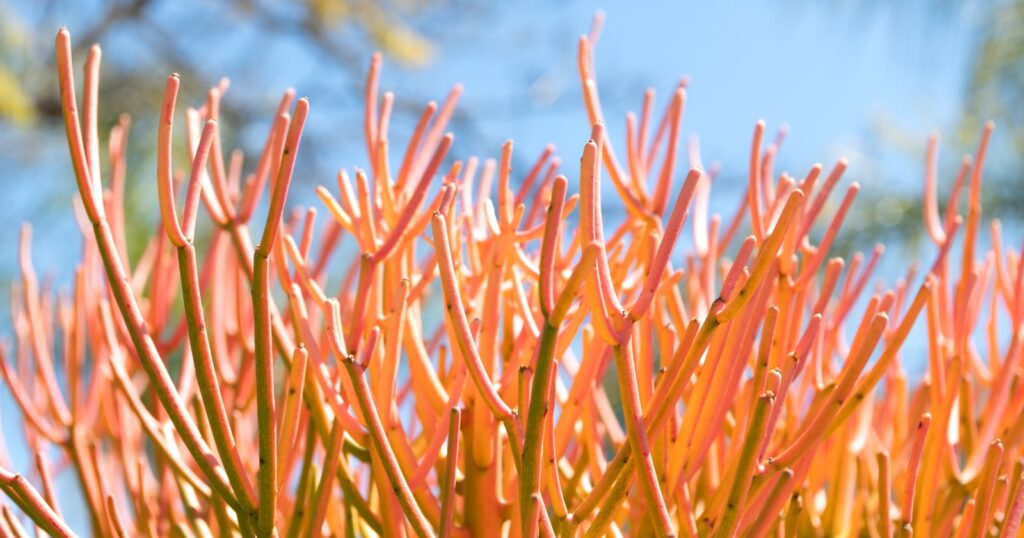
Scientific Name: Euphorbia tirucalli
- Plant Type: Succulent
- Plant Size: 6-8 feet
- Watering Needs: Low
- Sun Exposure: Full sun
Don’t be scared away by the tall size of the Pencil Tree. These plants are relatively slow growing and if yours becomes too tall for your liking, you can always prune it by removing some of the upper segments.
The Red Pencil Tree is toxic to both humans and pets. Do not grow this plant if you have young children or pets who may accidentally interact with it. This plant contains a toxic sap that is poisonous if ingested and can also cause skin irritation if touched. If you have a safe place to grow it, however, it is a very interesting looking plant.
Peperomia
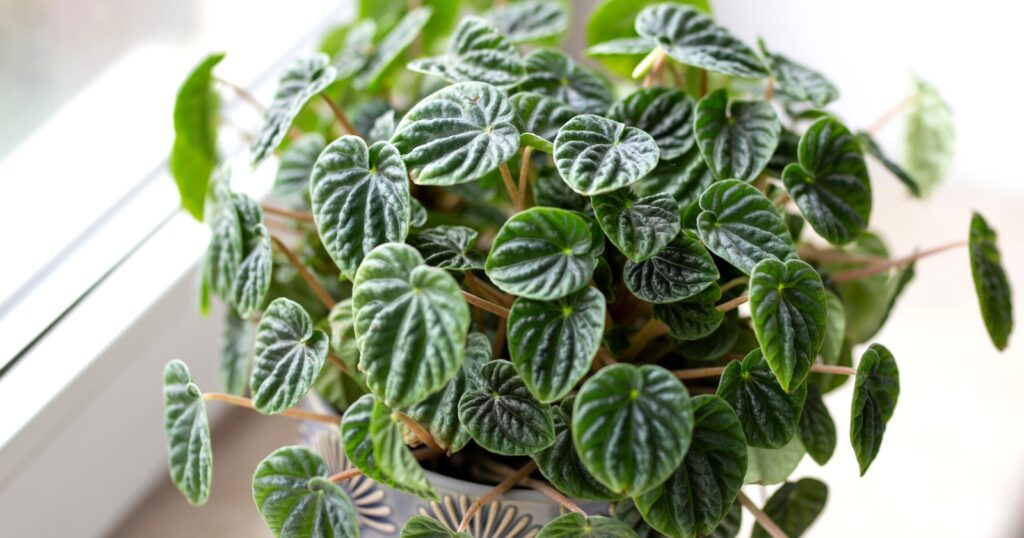
Scientific Name: Peperomia caperata
- Plant Type: Semi-succulent
- Plant Size: 6”-12”
- Watering Needs: Low to moderate
- Sun Exposure: Full sun to part shade
There are many varieties of Peperomia that are available as houseplants. They are low-maintenance and easy to care for, which makes them quite popular. This Peperomia has relatively thick stems and waxy, wrinkly leaves. The colors may be deep green to variegated combinations of green, silver, and purple.
Peperomia leaves appear to grow individually at the ends of long stems which emerge from the soil. Plants grow into a rather compact mound and they do readily flower when grown as houseplants, although the flowers are just a simple, non-showy, slender spike. Peperomia grow well in moderate light conditions and need water only after the soil has dried completely.
Pig’s Ear
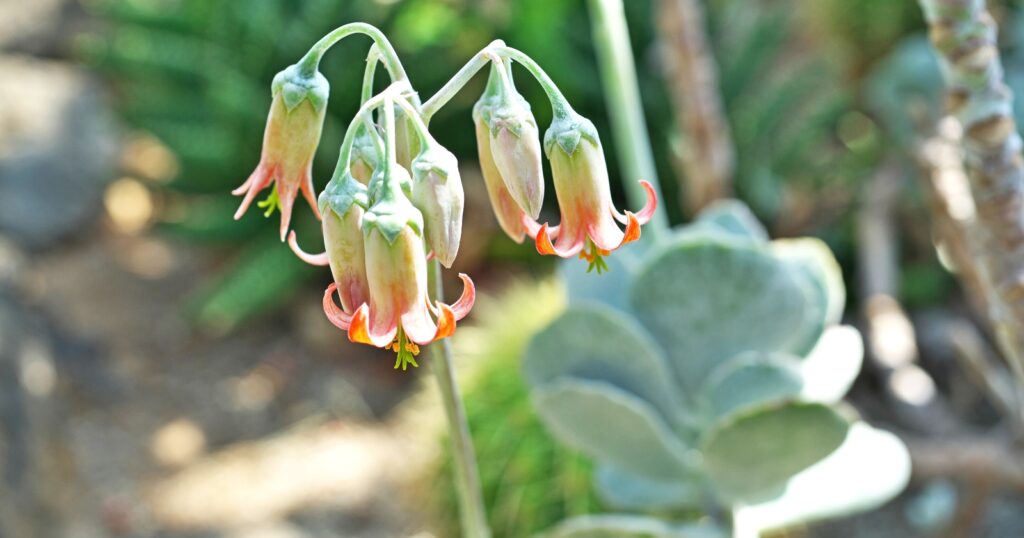
Cotyledon orbiculataScientific Name: Cotyledon orbiculata
- Plant Type: Succulent
- Plant Size: 1-2 feet
- Watering Needs: Low
- Sun Exposure: Full sun to part shade
Pig’s Ear looks somewhat like a Jade Plant, but with larger, pale green leaves. Leaves grow on thick upright stems. As the stems grow longer, lower leaves wither and drop, giving older and larger plants and shrub-like appearance. Plants grown in ideal conditions will develop tall flower stalks topped with a cluster of bright red tubular flowers.
Grow these plants in a larger pot with well-drained succulent soil. Allow the soil to dry completely between waterings. They can easily be grown as container plants outdoors in the summer. Before the first frost, bring them inside and set them in a sunny window area for winter.
Pincushion Cactus
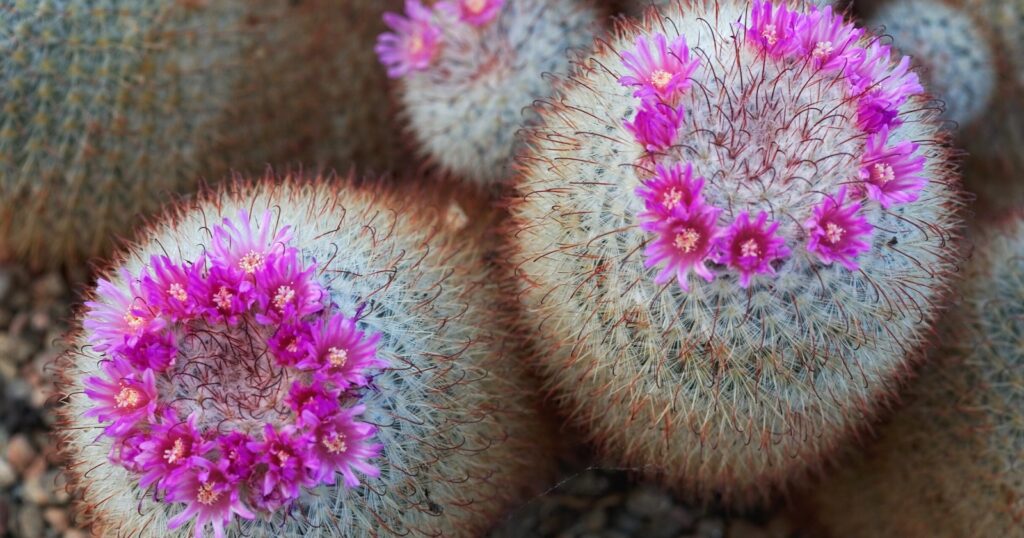
Scientific Name: Mammillaria crinita
- Plant Type: Succulent cactus
- Plant Size: 3”-6”
- Watering Needs: Low
- Sun Exposure: Full sun
This plant is a bit more “cactus” than the other succulents listed here, but it is worthy of mention. This is a low-growing plant that looks a bit like a prickly green sea urchin. Thick lobed protuberances with spiny tips grow from a central mound. In ideal conditions, this little plant will bloom with small, tubular, pale pink flowers.
Grow Pincushion Cactus is a warm location with plenty of bright sunlight. Water it only when the soil has dried completely. Make sure your pot has good drainage holes and use loose, well-drained, sandy soil.
Pinwheel Aeonium
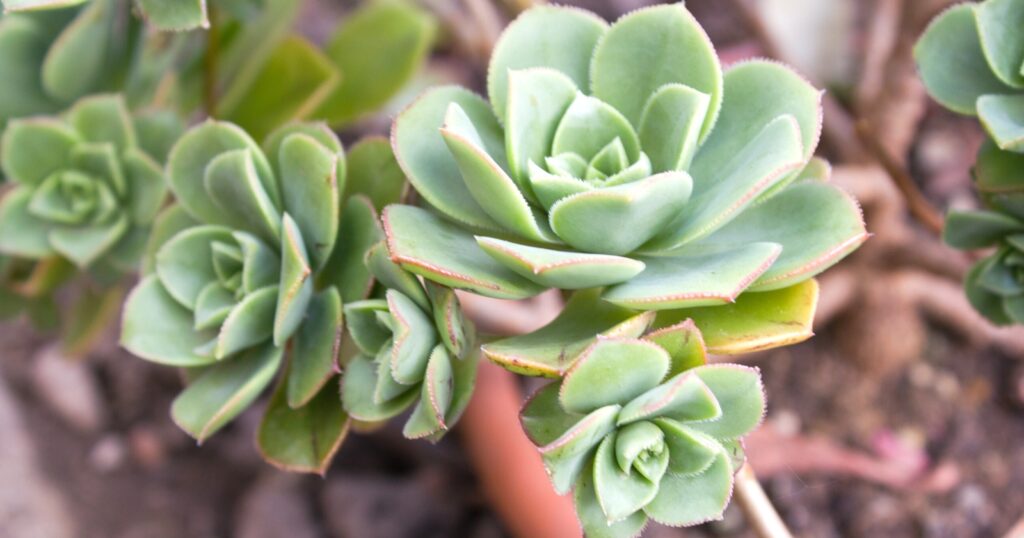
Scientific Name: Aeonium haworthii
- Plant Type: Succulent
- Plant Size: 6”-12”
- Watering Needs: Low to moderate
- Sun Exposure: Full sun
The Pinwheel Aeonium, or Haworth’s Aeonium, is a thick-stemmed branching succulent. Each stem ends in a leafy green rosette. While the stems may grow to 12 inches long, they tend to creep along the ground rather than grow upright.
Grow Pinwheel Aeonium in a wide, shallow pot to give it room to creep. It will eventually creep over the edges of the pot, in the manner of a dense ground cover. Use a well-drained soil that has a moderate amount of organic matter in it; standard organic houseplant potting soil is suitable.
Plush Plant
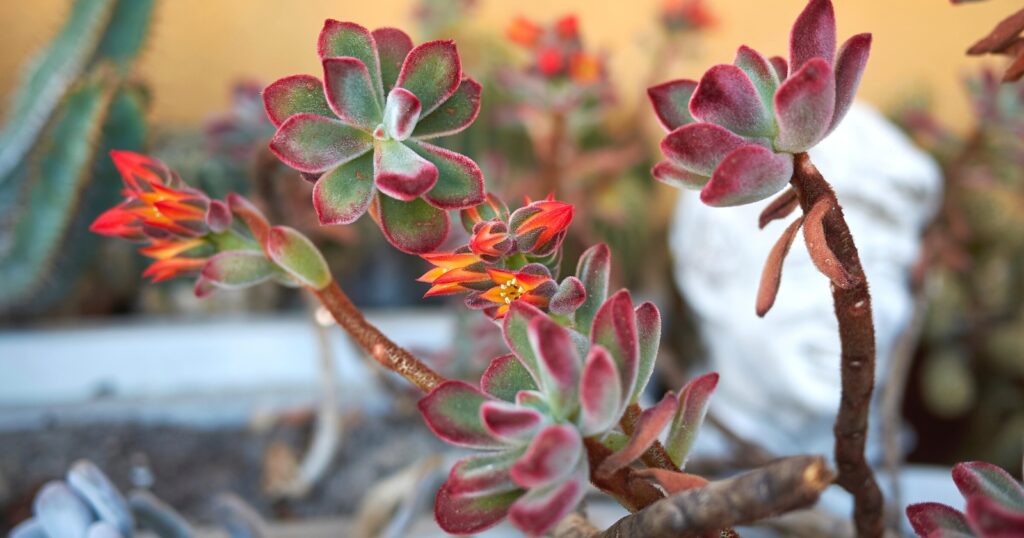
Scientific Name: Echeveria pulvinata
- Plant Type: Succulent
- Plant Size: 1-2 feet
- Watering Needs: Low
- Sun Exposure: Full sun
The Plush Plant has a dense layer of soft white fuzz on its pale green leaves, which makes them very soft to the touch. Leaves are bright green with pink to reddish tips. When grown in full sun, Plush Plant may develop a spike of colorful yellow and orange flowers. Plants will start by growing upright, but as they grow longer, they tend to become top heavy and end up trailing along at ground level.
Ponytail Palm
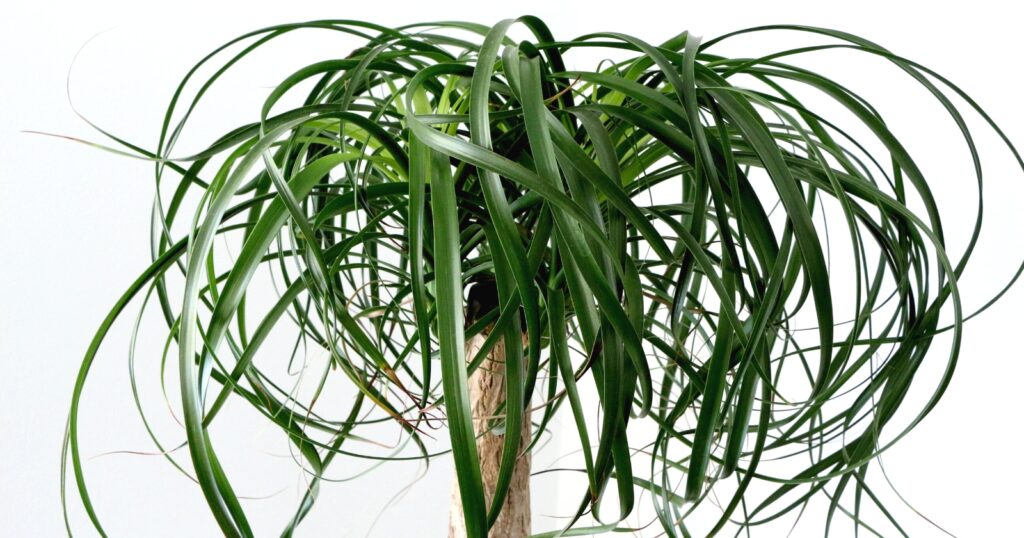
Scientific Name: Beaucarnea recurvata
- Plant Type: Succulent
- Plant Size: 4-10 feet
- Watering Needs: Low
- Sun Exposure: Full sun to part shade
Ponytail Palm is not actually a palm, but a type of succulent. It has a thick, succulent stem with a heavy rounded base. Long, thin, drooping leaves gently curl downwards from the top, giving the appearance of a giant green ponytail. In its native environment, this plant is very long-lived and can reach over 30 feet tall, but as a potted houseplant, they are slow-growing and rarely reach more than 4 feet tall.
Ponytail Palm prefers a location with bright sunlight, but seasonal bright light also works. For example, you can move your plant outside for the summer months, and then indoors to any window location for the duration of the winter.
Red Carpet
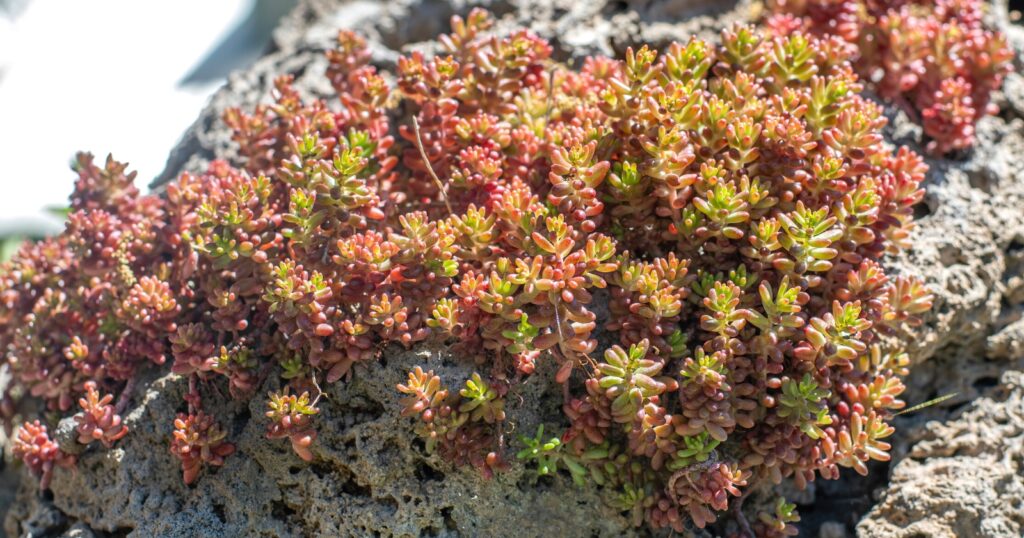
Scientific Name: Sedum spurium
- Plant Type: Succulent, Herbaceous perennial succulent
- Plant Size: 4”-6”
- Watering Needs: Low to moderate
- Sun Exposure: Full sun
Red Carpet Sedum is also sometimes called Caucasian Stonecrop or Two Row Stonecrop. This thick-leaved plant makes an excellent ground cover. Leaves range from pale green to soft pinkish-red. It can be grown outdoors in a rock garden or other sunny border and is hardy from zones 3 to 8. It can also be grown indoors as a houseplant. Give it plenty of sunlight and well-drained soil with some added sand or pearlite.
Sea Onion
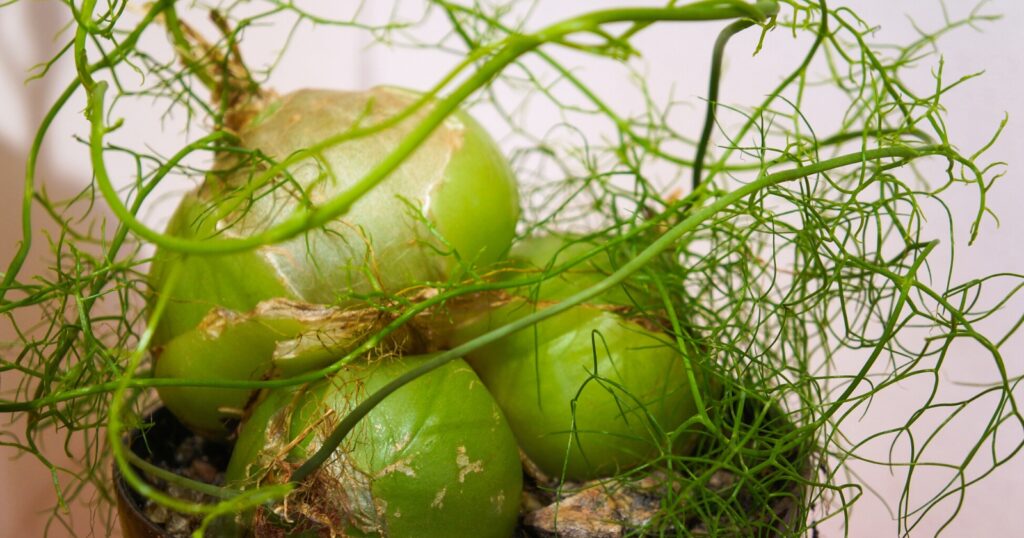
Scientific Name: Bowiea volubilis
- Plant Type: Bulbous succulent
- Plant Size: 2-3 feet
- Watering Needs: Low
- Sun Exposure: Full sun to part shade
The Sea Onion, or Climbing Onion, is a rather unusual looking plant. It has a thick succulent bulbous base. From this base, fine green tendrils grow and branch, draping over the edge of the pot or loosely climbing a trellis. Tiny, green, star-shaped flowers appear along the tendrils. Over time, new bulbs will form next to the mother plant and these can be divided, if desired.
This plant is relatively easy to grow. Plant it in well-drained soil and water only when thoroughly dry. Plants do not tolerate wet or soggy soil and will quickly rot. Place the pot in a sunny window. Be prepared for periods of active green growth and periods of dormancy, when the plant dies back, and doesn’t require watering until it starts to regrow again.
Short-leaved Aloe
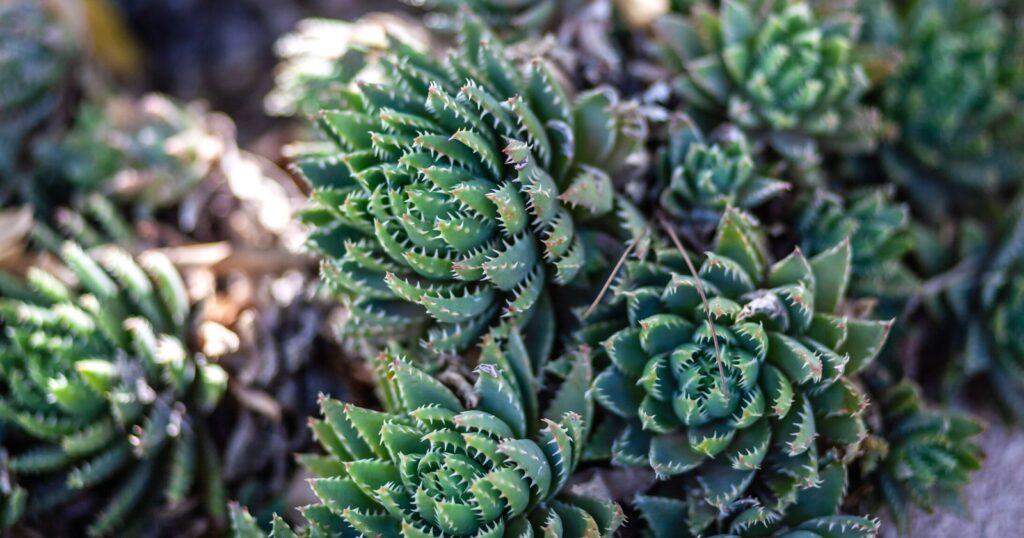
Scientific Name: Aloe brevifolia
- Plant Type: Succulent
- Plant Size: 1-2 feet
- Watering Needs: Low
- Sun Exposure: Full sun
The Short-leaved Aloe is a dense leafy rosette of thick leaves. Leaves vary in color from shades of pink to shades of pale bluish-green, and are edged with sharp spines. The very attractive fleshy rosettes grow into a clump over time and make a dramatic and colorful potted plant.
Plant Short-leaved Aloe in a pot with some room to spread. Use well-drained sandy soil and place them in an area with bright sunlight. You can set them outside in the summer, but bring them in anytime the temperature might drop below freezing.
Snake Plant
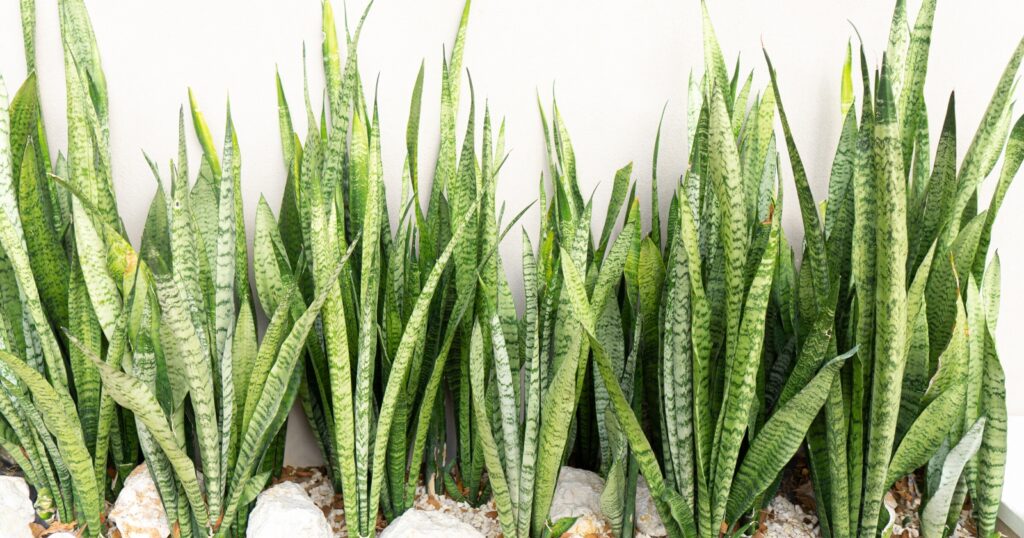
Scientific Name: Sanseveria trifasciata
- Plant Type: Succulent
- Plant Size: 2 feet
- Watering Needs: Low
- Sun Exposure: Part shade to shade
These long-leaved plants may not look like a typical succulent, but they are. Snake Plants have long, single, leathery leaves that emerge from the soil. Leaves are mottled green and look rather dramatic emerging straight from the pot.
Snake Plants are remarkably easy to grow and low-maintenance. They will tolerate a range of light conditions and soil conditions. Snake Plants are slow-growing and you can easily enjoy their vegetation without much work. They will grow well in low to moderate light, and with a basic houseplant potting soil or soil formulated for succulents.
‘Starfish’ Sansevieria
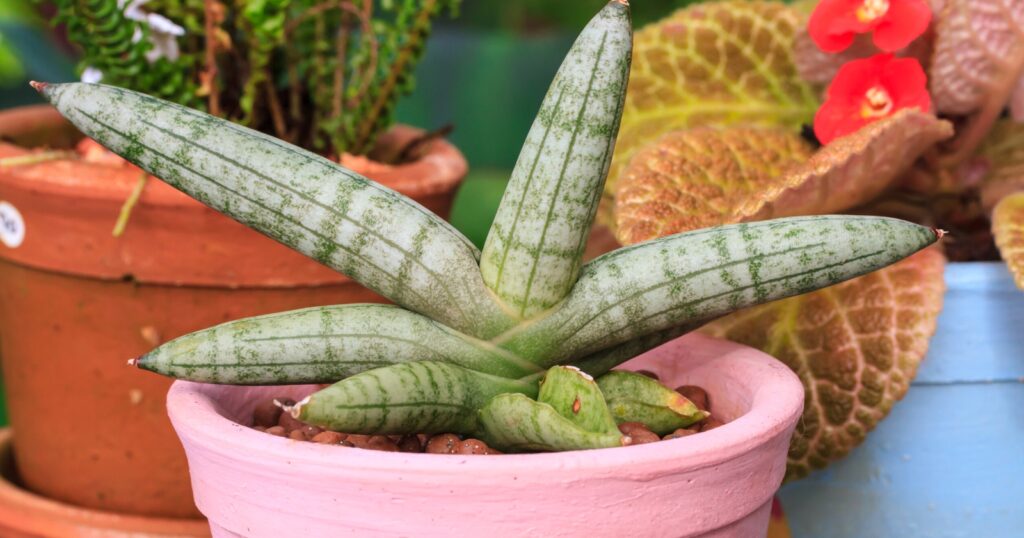
Scientific Name: Sansevieria cylindrica ‘Boncellensis’
- Plant Type: Succulent
- Plant Size: 3-4”
- Watering Needs: Low
- Sun Exposure: Full sun to part shade
This unusual plant has thick rounded tubular leaves that end in a dull point. Leaves grow from the center and eventually the plant grow into a stumpy fan shape. The leaves are variegated shades of green and very smooth. This quirky plant is sure to be a conversation piece.
Grow the ‘Starfish’ Sansevieria in a loose, well-drained soil. Water only when the soil has thoroughly dried. Give this plant plenty of light, but it doesn’t require full sun to thrive. It should do fine in any indoor location with some bright outdoor light.
String of Buttons
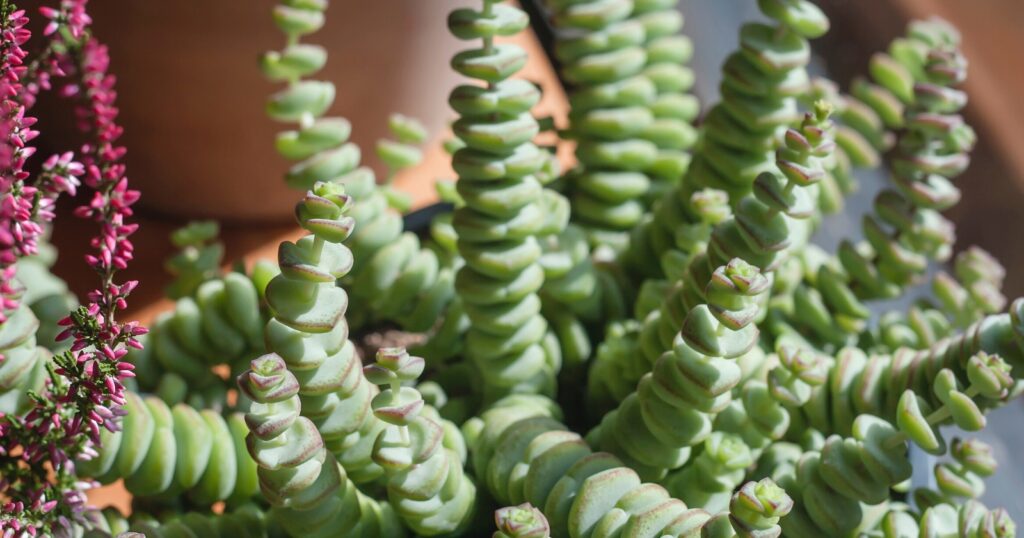
Scientific Name: Crassula perforata
- Plant Type: Succulent
- Plant Size: 1-2 feet
- Watering Needs: Low
- Sun Exposure: Full sun to part shade
String of Buttons grows a stem with can reach 2 feet long, although often stays more compact as a houseplant. The stem is densely packed with thick, fleshy, broadly triangular leaves. Because of the way the pairs of triangular leaves grow in alternating directions, the overall shape of the leafy stem may appear almost square.
Leaves are light green with appealing reddish edging and speckling. This attractive little plant does well in a bright and sunny window. Given enough time, String of Buttons may grow over the edge of the pot, but it typically maintains an upright growth habit rather than dangling over the edge.
String of Pearls
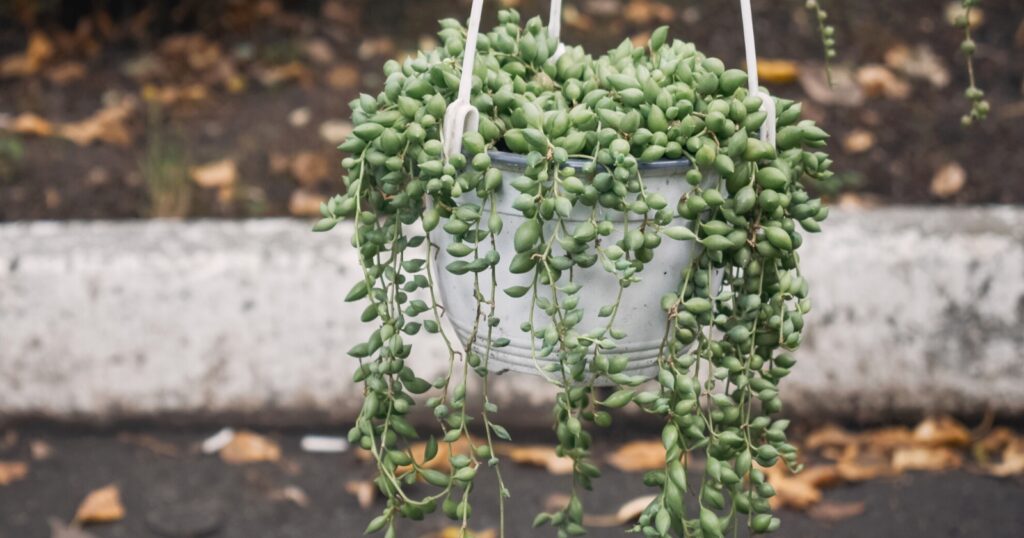
Scientific Name: Curio rowleyanus
- Plant Type: Succulent
- Plant Size: 1-2 feet
- Watering Needs: Low
- Sun Exposure: Full sun to part shade
This distinctive succulent is widely available commercially and is easy to grow. Long stems are lined with little green peal-like leaves. When growing entirely within a pot, the appearance is like a pot filled with bright green peas! As the stems grow longer, they will drape over the edge of the pot. Any stems that break off can be propagated simply by allowing them to root on fresh, lightly moist soil.
Stone Plant
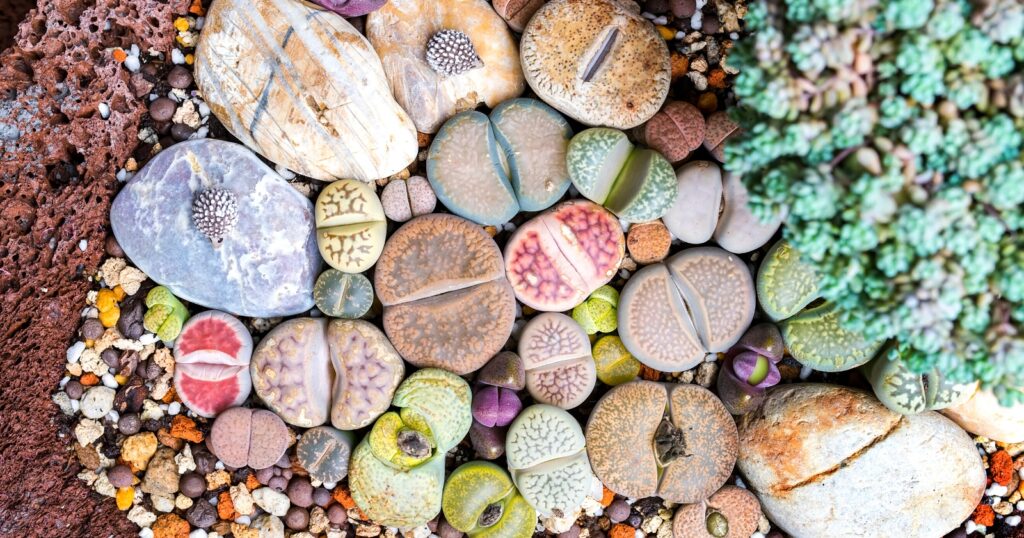
Scientific Name: Lithops spp.
- Plant Type: Succulent
- Plant Size: 0.5”-1”
- Watering Needs: Low
- Sun Exposure: Full sun
The Stone Plant, or Living Stone, is a really unique plant. Short, flattened leaves grow very low to the ground and look like polished pebbles.Leaves grow as a very thick pair and are quite distinctive and odd looking. Plants grow slowly and will eventually divide into a small cluster.
Be very careful about overwatering and water only sporadically. These plants need very little water and are prone to rot if given too much. They also need as much light as you can offer. They would do best in a very sunny window with at least 6 hours per day or bright light.
Torch Plant
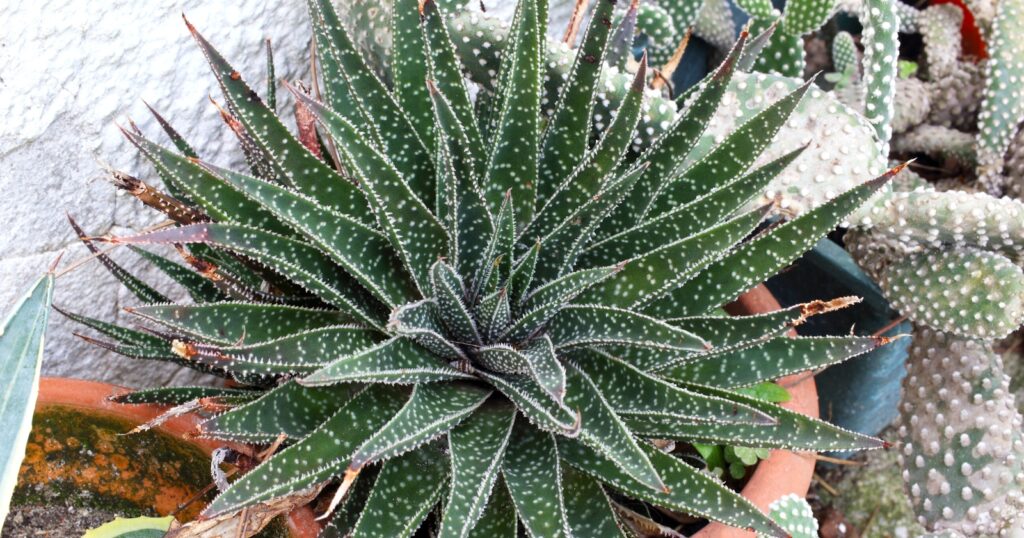
Scientific Name: Aloe aristata
- Plant Type: Succulent
- Plant Size: 0.5-1 foot
- Watering Needs: Low
- Sun Exposure: Full sun to part shade
The Torch Plant, also sometimes known as Lace Aloe, is interesting and low-maintenance. This dramatic plant grows in a dense leafy rosette. Leaves are medium to deep green, flecked with rough white speckles, and edged with toothy spines. Plants tend to stay low and compact, rather than trailing or sprawling, making them ideal candidates for growing as a potted plant in a sunny window location.
Tree Houseleek
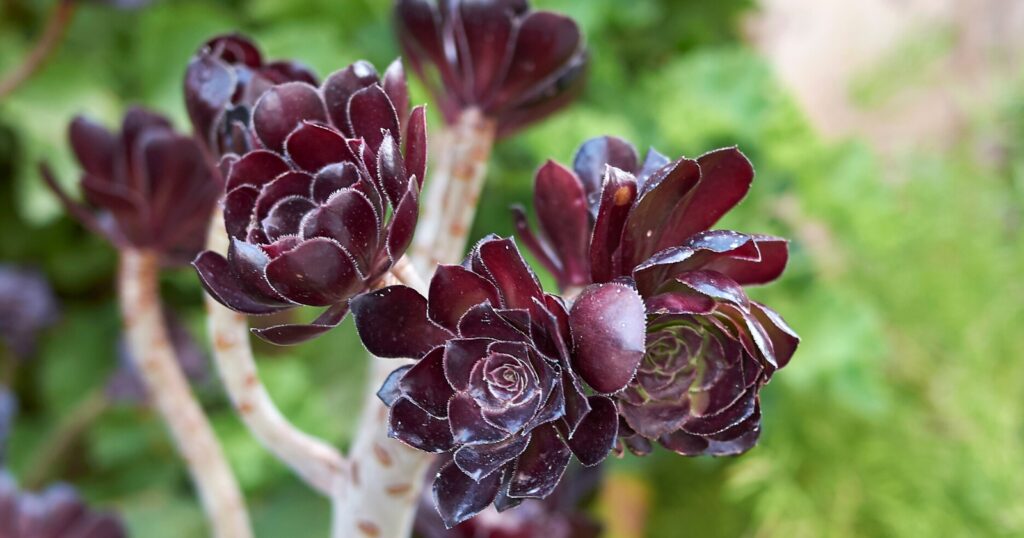
Scientific Name: Aeonium arboreum
- Plant Type: Succulent
- Plant Size: 3-5 feet
- Watering Needs: Low
- Sun Exposure: Full sun
The Tree Houseleek is a succulent that has the potential to grow rather large, but it can also be grown indoors as a potted plant. It has thick branching stems topped with bright green leafy rosettes. Some varieties have deep purple leaves which give these plants a very exotic look.
Tree Houseleek can be grown in a large pot with good drainage and sandy, well-drained soil. Put it in a sunny window with plenty of bright sunlight and you can move it outside for the summer months. Plants can be grown from seed or by a cutting of a leafy rosette with a bit of stem.
Zebra Plant
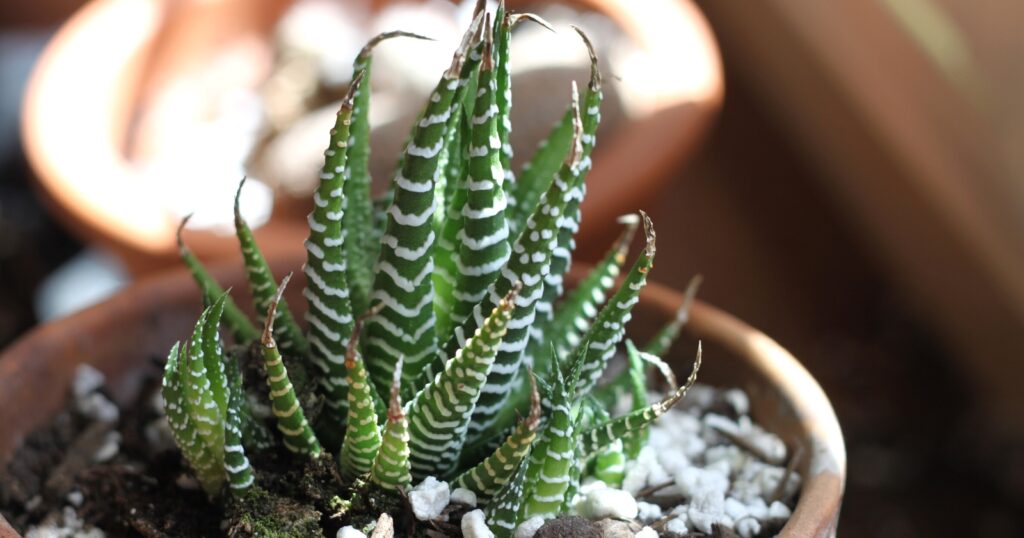
Scientific Name: Haworthiopsis fasciata
- Plant Type: Succulent
- Plant Size: 4”-5”
- Watering Needs: Low
- Sun Exposure: Full sun to part shade
The Zebra Plant, or Zebra Haworthia, is an easy care succulent that is readily available commercially. Leaves are thick and tough, dark green with white bands, thicker at the base and tapering to a point. It grows as a compact leafy rosette and new plants will gradually develop spread outwards from the central mother plant. When the pot gets crowded, rosettes can be easily divided and repotted.
Final Thoughts
If you have a sunny window and a sense of adventure, there’s probably a succulent that’s right for you. With so many interesting and diverse varieties, it’s easy to start growing and collecting succulents. Remember a few key points that will help with your succulent growing success:
- Give your plants plenty of bright sunlight.
- Soil should be well-drained.
- Use a pot with good drainage holes.
- Water your plants sparingly, allowing soil to dry between waterings.
- Be careful with potential plant hazards (toxic, spines, sharp edges)..
- Pay attention to the specific needs of each variety.
- Choose plants well-suited for the conditions you can offer.
The most important thing to remember with your succulents, is that you enjoy growing them! They are amazing plants that will last for a very long time given the right care!

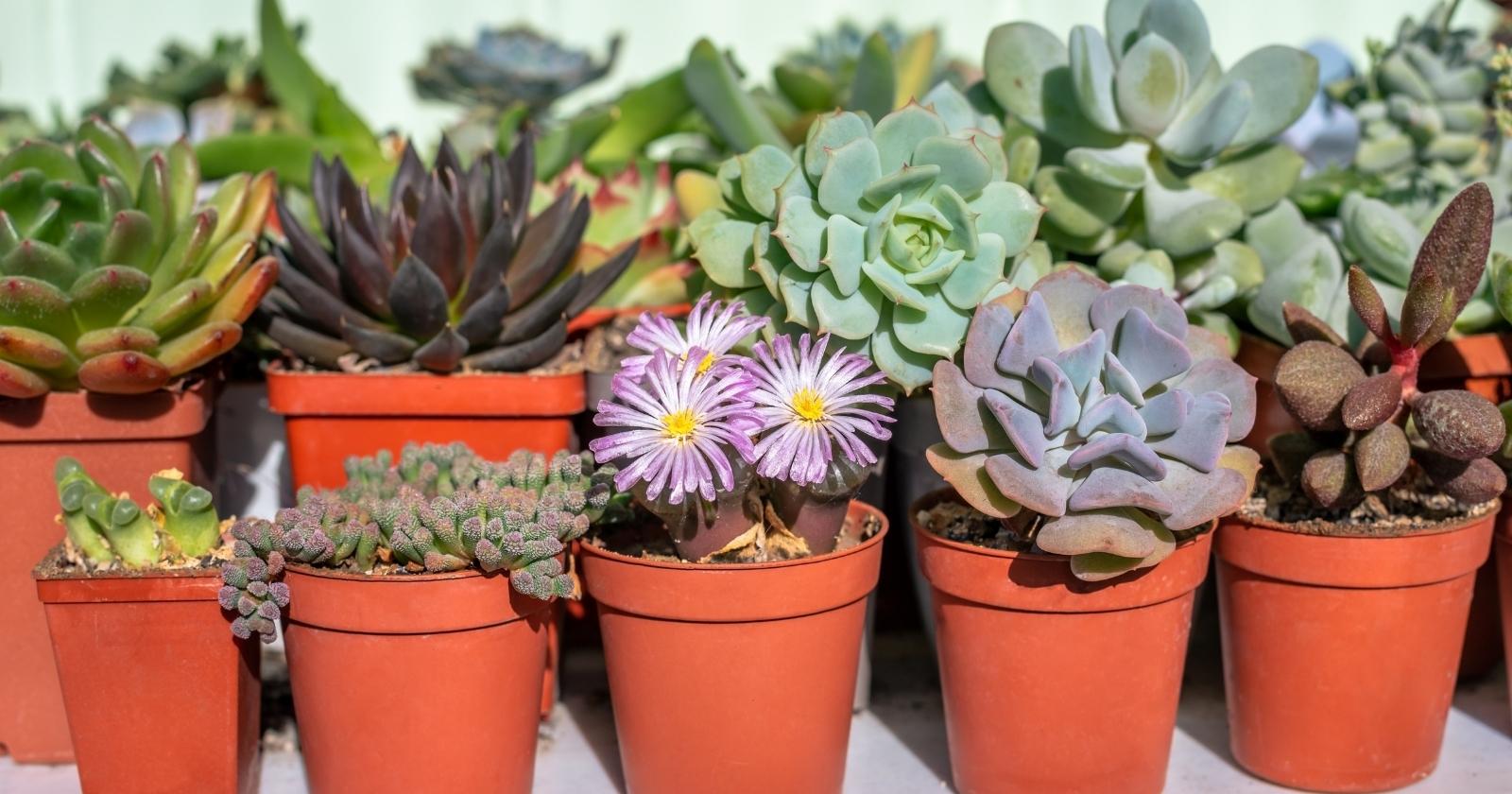
Leave a comment